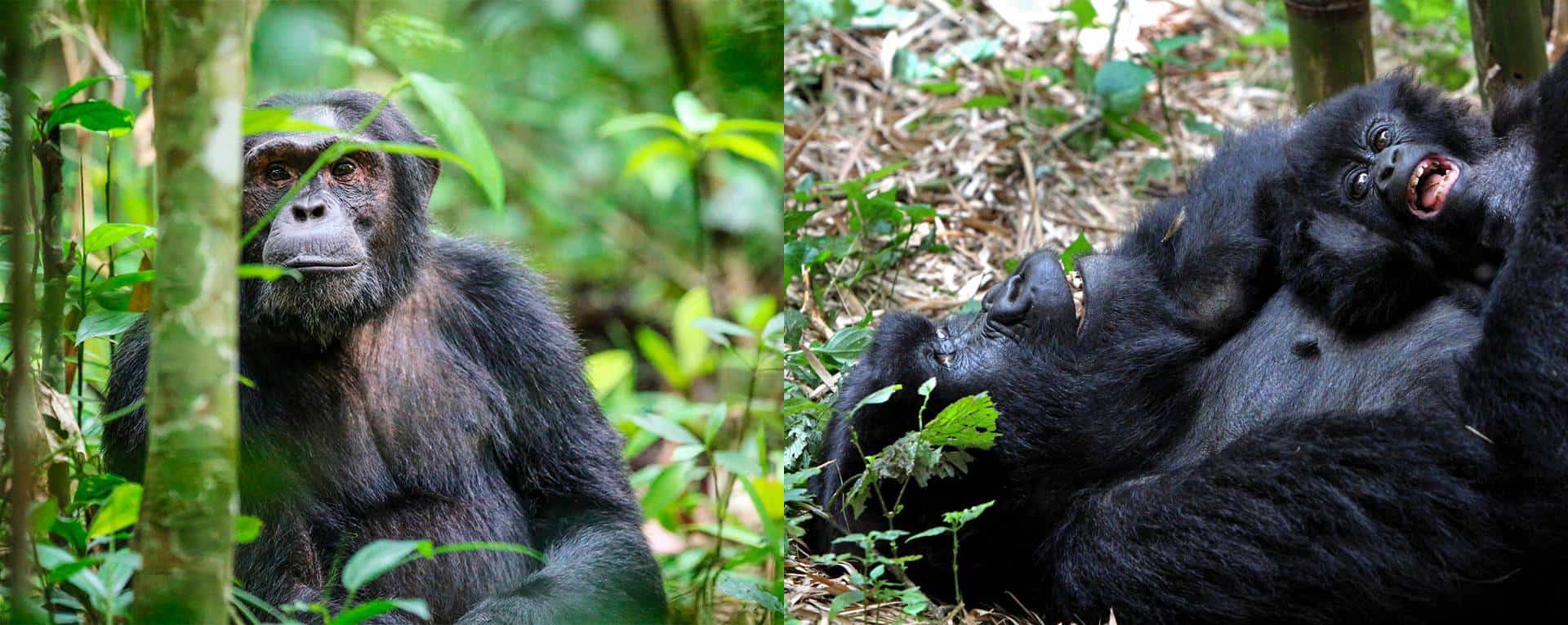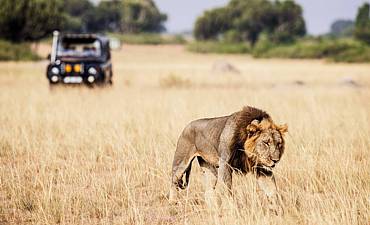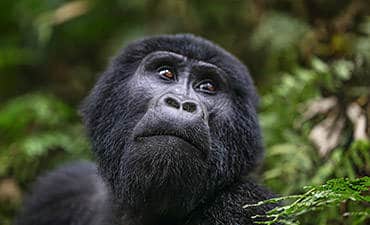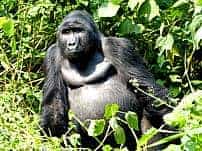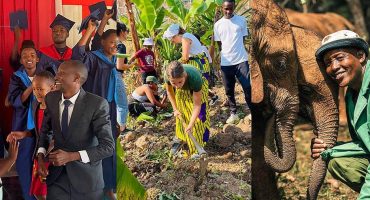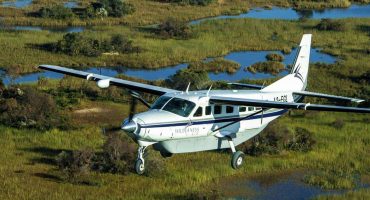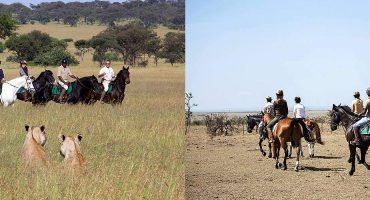GORILLA TREKKING & CHIMPANZEE SAFARIS PLANNING GUIDE FOR UGANDA
Learn More On AfricanMecca Safari Tier Ratings & Experiences
READ MORE ON TRAVEL GUIDE FOR UGANDASelect Your Planning Guide Option
1. Gorilla Trekking Safaris Guide For Uganda
2. Chimpanzee Trekking Safaris Guide For Uganda
How To Plan The Best 2026-2027 Gorilla Safari Treks For Uganda?
Hidden away in the heart of Africa, in a misty, mountainous region shared by Uganda, Congo, and Rwanda is a mysterious habitat – a refuge of the last surviving species of a rare kind of primates. Mountain gorillas of Africa are a close relative of humans, sharing 98% of their DNA. They live and roam in these mountains, traveling between the three countries in their quest for food and shelter. Explorers, wildlife enthusiasts, conservationists, and anthropologists flock to these lands to track and spend a precious hour in their company. You could be one of them, navigating the forest treks of Uganda to find the primates in their favorite locales.Key Takeaways
- Exploring the misty mountain region shared by Uganda, Congo, and Rwanda, the last-known habitat of the mountain gorillas
- Spending time with one of the 21 gorilla families in Uganda that wander in search of territorial rights, food, shelter and forest life
- Areas of exceptional interest for anthropologists, wildlife enthusiasts, explorers, and conservationists
- Learning about the behavior, feeding habits, habitats, physical characteristics, and individual personalities of the gorilla family assigned to you
- Opportunity to track down golden monkeys in the bamboo forests of the Virungas
Page Content - Start Here
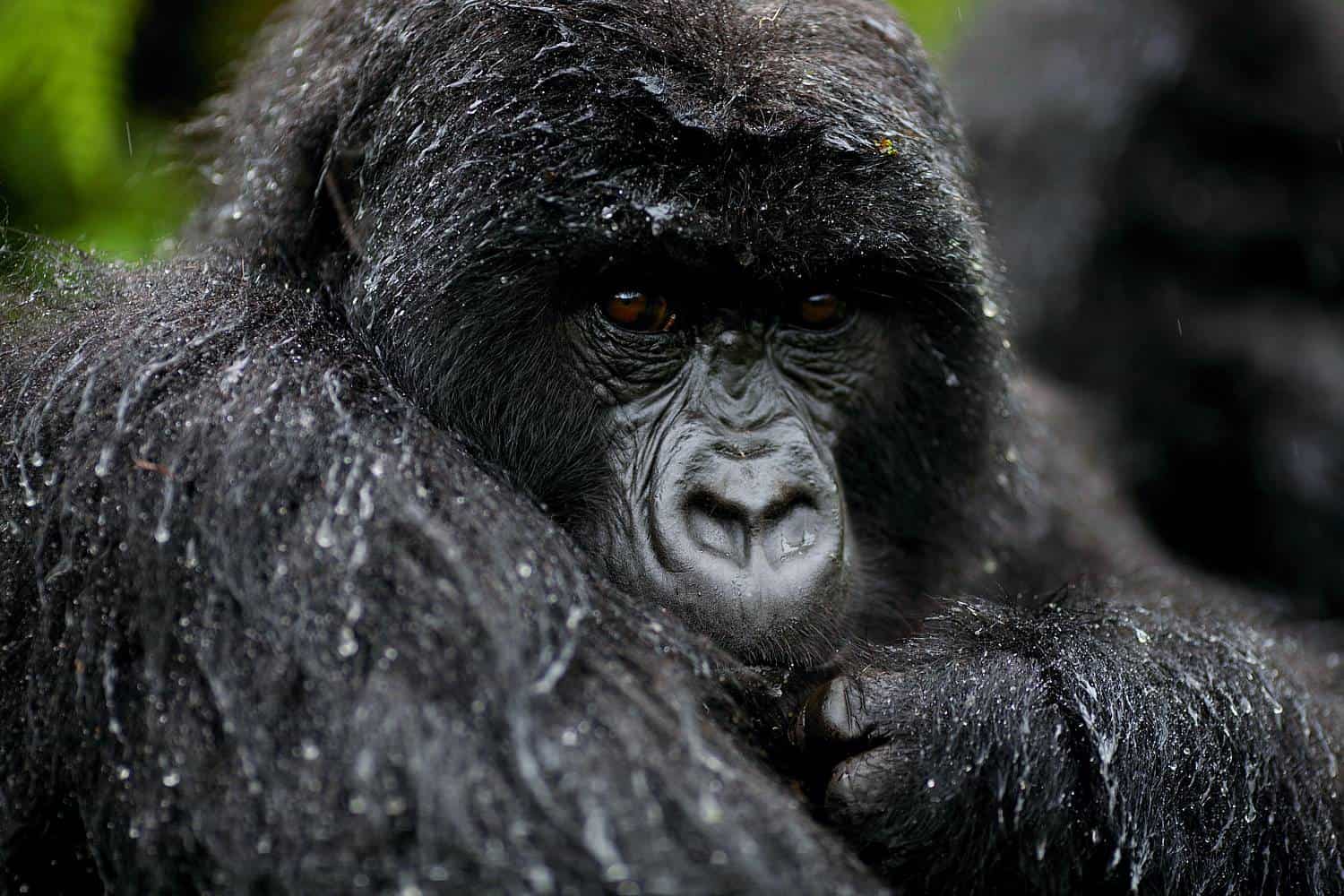 |
1. Where To Go On Gorilla Trek Safaris In Uganda?
Key Takeaways
- 20 gorilla habituated families known to live in the Bwindi Impenetrable National Park with a 1 family in the Mgahinga Gorilla National Park
- Learning about how conservation efforts have been successful in bringing them back from the brink of extinction
- Understanding the need for protecting these wondrous primates from poaching and trafficking gorilla hands
There’s no doubt that the time you spend watching the gorillas of Africa in their habitat will impress upon you the critical need to protect them. Indiscriminate poaching and demand for gorilla hands as trophies drove these primates to the brink of extinction, but thanks to recent conservation efforts, about 1,000 of them currently survive in the wild. If you’re visiting countries outside of Uganda, you can also find mountain gorillas in Volcanoes National Park in Rwanda and Virunga National Park in Congo.
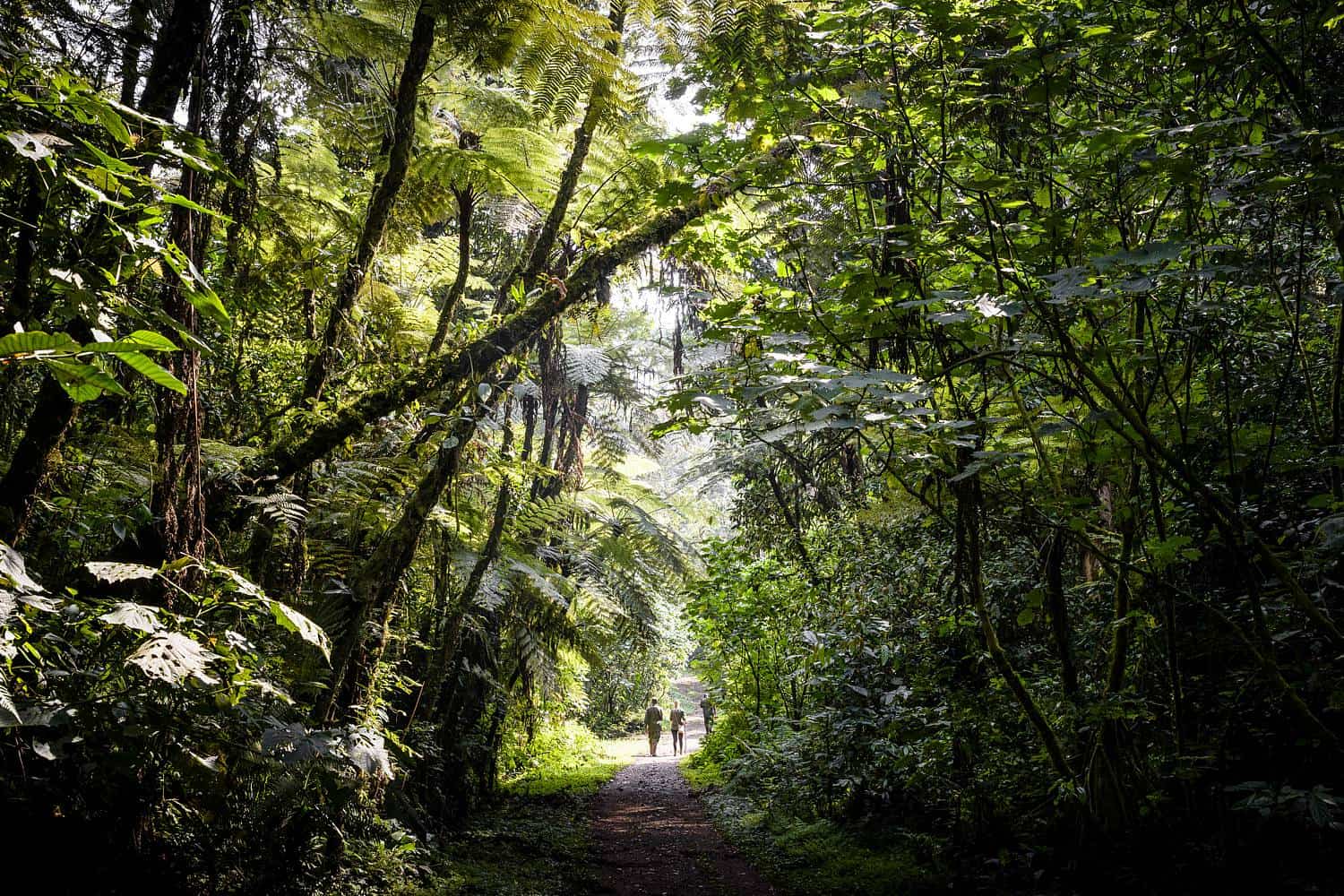 |
2. Physical Characteristics Of Uganda Mountain Gorillas
Key Takeaways
- Fully-grown male gorillas standing at 6 feet on their hind legs and weighing 300 to 500 pounds
- Females are smaller, growing to half the size of the males
- Living in families with the dominant silverback leading the group that comprises females, juveniles, and babies
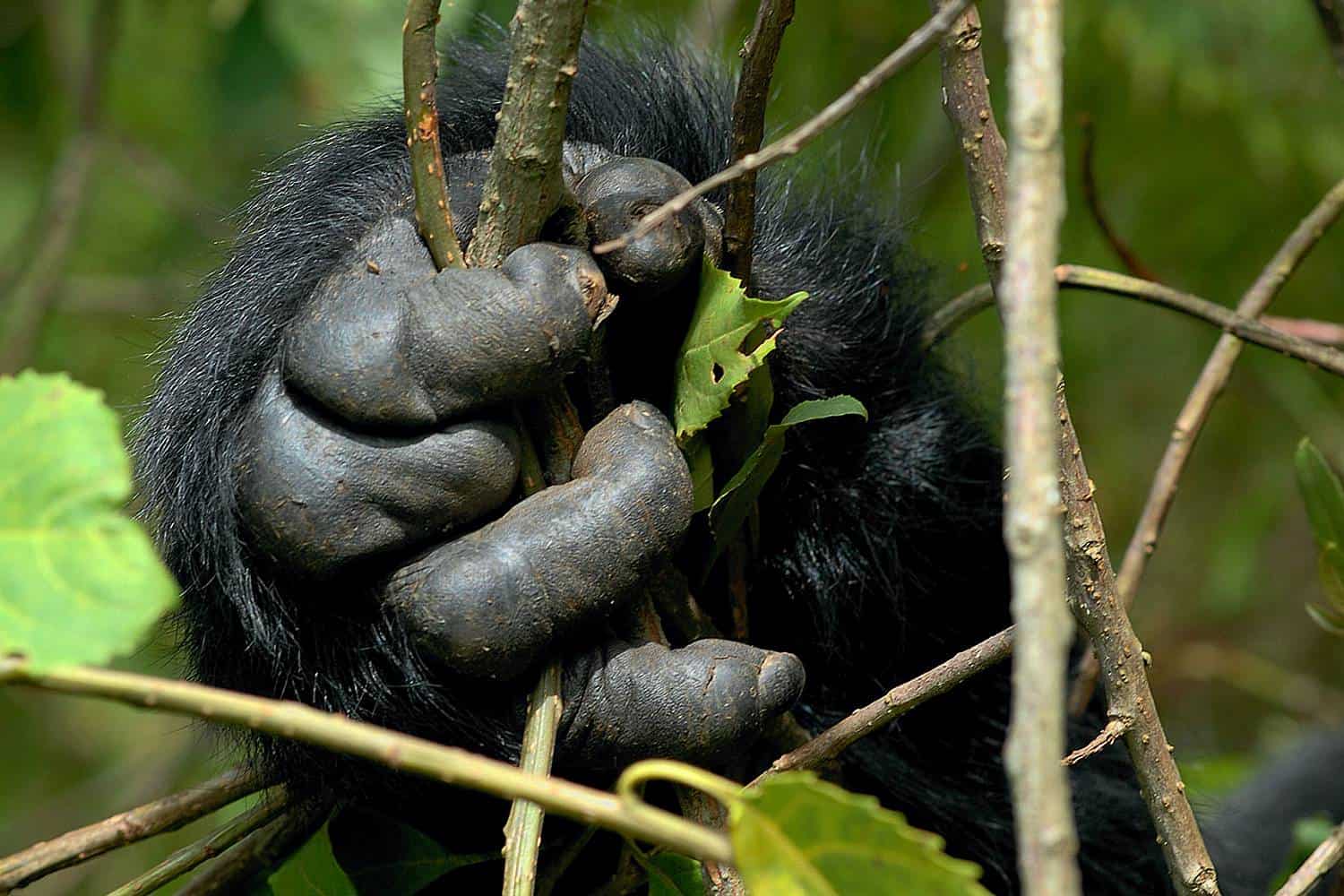 |
3. Behavioral Characteristics Of Mountain Gorillas In Uganda
Key Takeaways
- Nomadic lifestyle in the highlands of Uganda with a preference for the higher slopes during the dry season
- Incredibly gentle creatures with aggressive behavior only intended to scare off intruders rather than cause actual harm
- A primary diet of vegetation with nights spent in nests made with branches, twigs, and grass
Upon finding your assigned family on a gorilla safari trek, you will be struck by the similarities between gorillas and humans. They are incredibly gentle beings, and even the alpha males treat the babies with tenderness. Any aggressive behavior they display is only intended to scare off intruders, and they rarely get into actual fights with members of other families; most meetings between different families are amicable.
Mountain gorillas are extremely intelligent and have been known to open the snares that poachers put down to trap them. Their favorite foods include stinging nettles, thistles, bamboo, bedstraw, leaves, roots, wild celery, and fruit. These foods contain high water, content which is why gorillas rarely drink water.
Each group is led by a dominant male silverback and may have up to 30 members. The silverback takes care of the family, leading them to find food and safety, but usually staying within a radius of 10 to 15 square miles in the remote parks of Bwindi and Mgahinga. Gorillas spend most of their time on the ground. At night, they build nests with branches, twigs, and grass to sleep. As your tour guide will explain, the locals call them ngagi in Swahili, and they observe a strict hierarchy within the family.
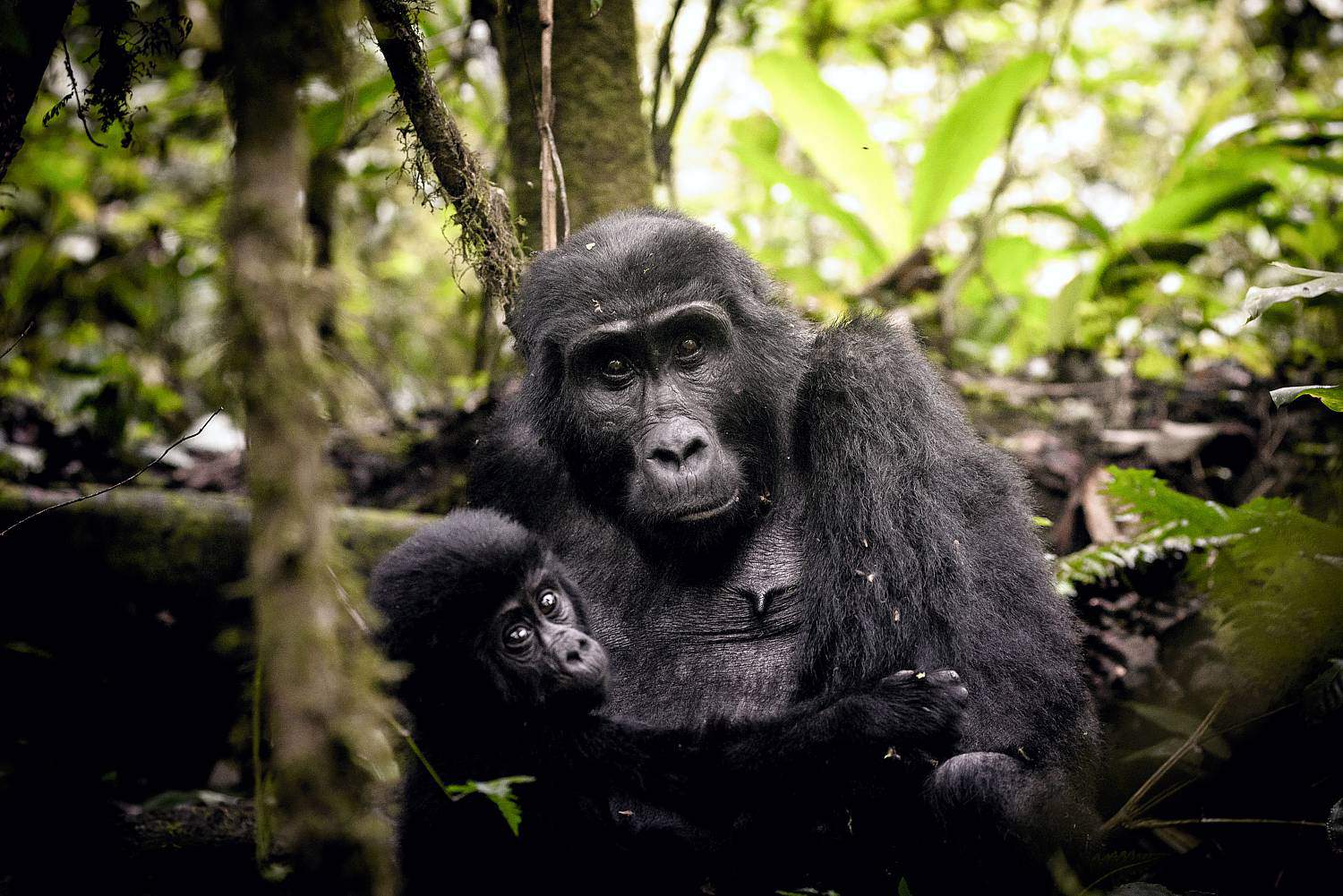 |
4. How To Prepare For Your Uganda Gorilla Safari
Key Takeaways
- Once-in-a-lifetime opportunity to see the rare mountain gorillas in their natural habitat. Over 90% probability of spotting the gorilla family assigned to you. You will spend one hour in their company observing their behavior
- Vacationers advised to book at least 3 days (2 nights) stay to experience all the wonders of the park
- Good physical shape required to navigate hilly terrain and tolerate unpredictable weather conditions
As your safari vacation consultant at AfricanMecca Safaris will advise, weather conditions in the highlands are unpredictable, and you may have to deal with quick changes without much warning. With hilly terrain, steep paths that are often unmarked, and thick undergrowth, trekking in the reserve can be difficult. For this reason, most trekking outfits require that their guests be in good physical shape to endure the hot weather, steep and uneven elevations, and treks that can take up to 8 hours or more.
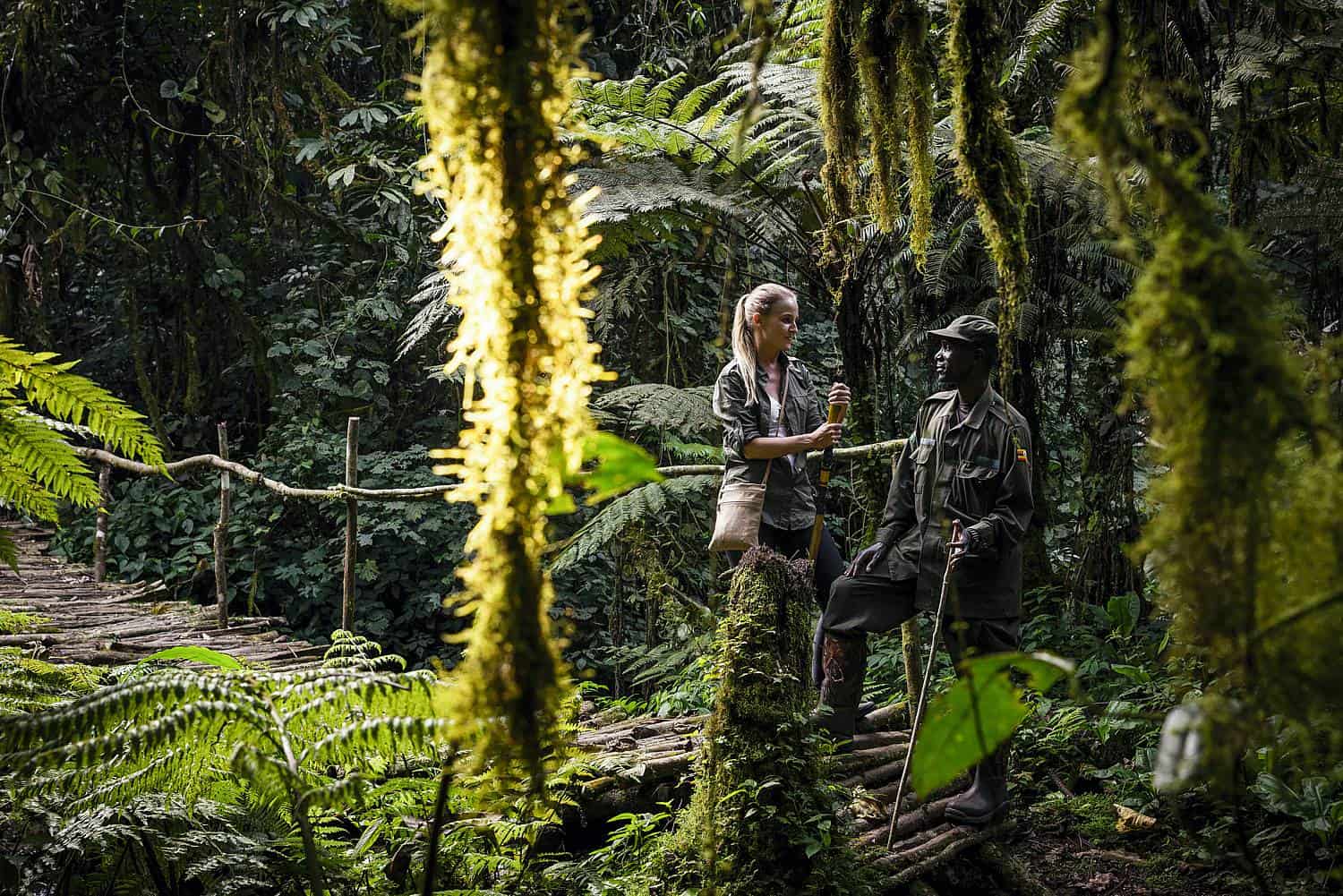 |
5. Assistance Of Uganda Ranger Guides, Gorilla Trackers & Porters
Key Takeaways
- Expert ranger guide and trackers assigned by the Uganda Wildlife Authority to assist visitors
- Porters available to carry food, beverages, and other supplies for the trek. Separate fees paid directly to porters
- Permits issued to visitors only, porters must remain at a distance. Enjoyable the experience with sightings of small fauna and indigenous flora
The fee for booking a porter is around US $20, and subject to change. Note that this fee isn’t paid in advance, but rather directly to the porter after the trek. You always have the option of carrying your gear yourself; however, hiring the services of a porter contributes to the community and supports their livelihood. You will also receive insights into the flora and fauna you see, and enjoy listening to some of the traditional local lore and fascinating myths.
Once you near the safe viewing distance of 5 to 7 meters from the gorilla family, your porter will ask you to take the items you need for the next hour and proceed without him. This is because, in an attempt to minimize the contact that humans have with the gorillas of Uganda, porters are not given permits. Your guide and porter will take complete care to enforce these regulations.
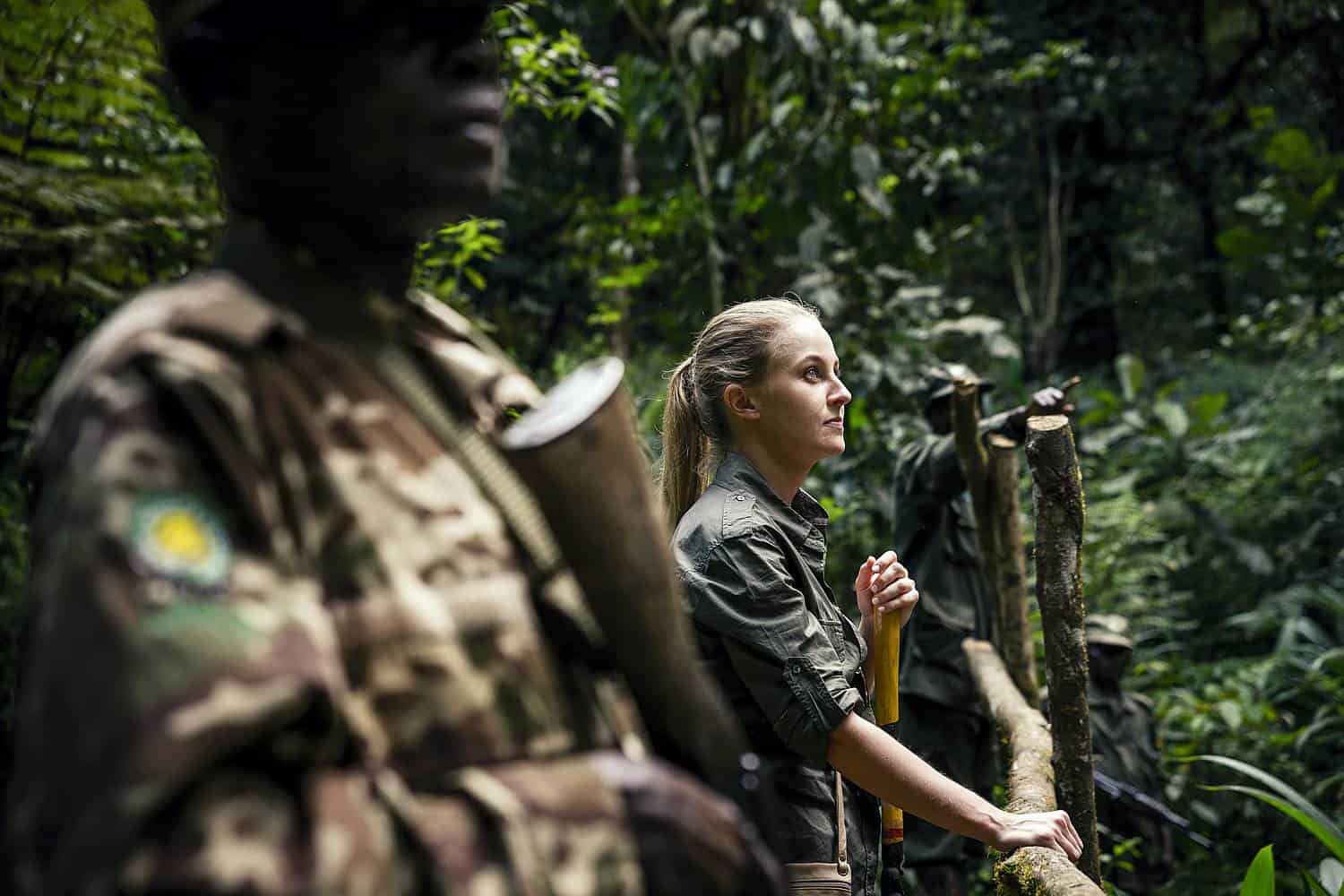 |
6. Essential Gear To Bring On Your Uganda Gorilla Trek
- Worn-in waterproof lightweight hiking boots separate from your daily regular wear
- Garden gloves to protect from holding thorns, brush and stinging nettles
- Trekking gaiters and lightweight long socks
- Outdoor/waterproof and breathable pant and insulated jacket (preferably Gortex) with hood to wear on top of your quick dry undershirt. Poncho is a good lightweight alternative to a waterproof jacket.
- Lightweight fleece sweater - helps in layering for cool mornings.
- Wet wipes
- Good size bottled water
- Camera
- Fully-wrapped energy snack bars
- Absorbent towel for sweat and moisture wiping
- Hat, sunblock, and sunglasses with neck strap
- Small and lightweight backpack to carry your gear
- Walking sticks
7. Permitted Age Limits For Gorilla Trekking In Uganda
The Ugandan authorities strictly enforce the minimum age of 15 years old for safari holiday guests who want to view the gorillas, while it is 12 years for chimpanzees, and golden monkeys.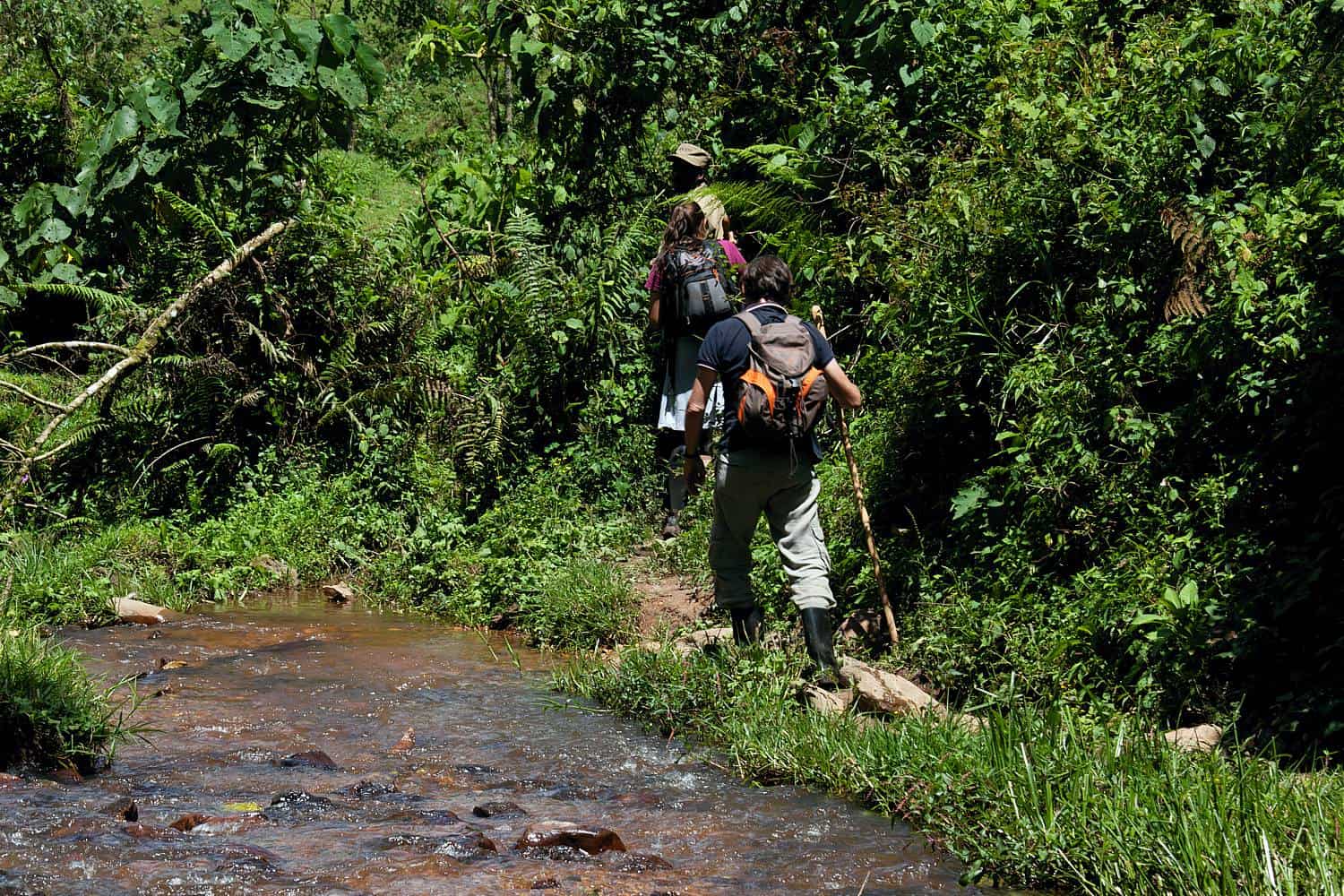 |
8. Uganda Regulations For Taking Photographs & Videos
Key Takeaways
- Taking personal pictures and videos with digital and SLR cameras permitted
- Professional movie and media photographing allowed for a fee
- All rules and regulations must be followed including keeping the flash off
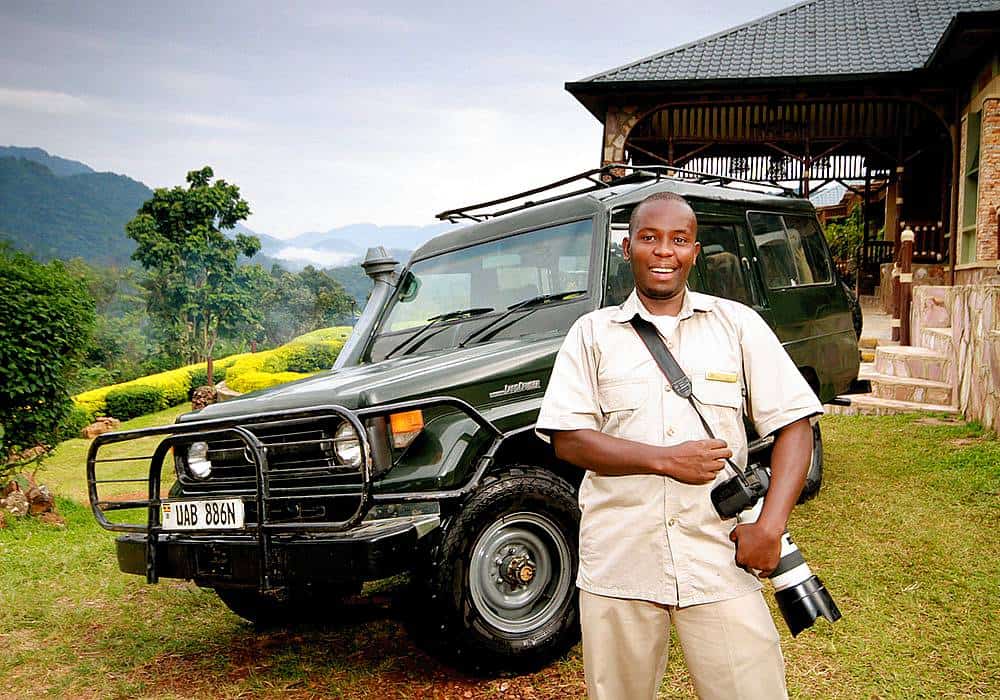 |
9. Important Guidelines For Tracking Down Gorillas In Uganda
Key Takeaways
- Several regulations and protocols instituted by the Uganda Wildlife Authority to protect the primates
- Visitors suspecting of having transmittable diseases not permitted to visit the gorillas
- Primates are susceptible to contracting diseases because of their underdeveloped immune system
Here are the other rules:
- You are allowed just 1 hour with the gorilla family
- You must remain at a distance of at least 7 meters (22 feet) from the primates; if they move closer to you, move away slowly to maintain the gap
- Each group can have 8 guests; only one group per day is allowed to visit each family
- Talk in low voices around the gorillas, and refrain from making any sudden movements that may scare them
- No eating or drinking in the presence of the gorillas
- Spitting or littering in Bwindi and Mgahinga is strictly forbidden
- If you must cough or sneeze, quickly cover your nose and mouth and step away
- Never look a gorilla in the eye, which may signal that you are challenging him to a fight
- When taking pictures of the primates, take care to turn off the flash and camera clicking sounds
- If a gorilla charges at you or grunts or roars, stand very still; do not display fear or run, but rather lower your head in submission, turn your gaze away, and follow the instructions of your safari guide.
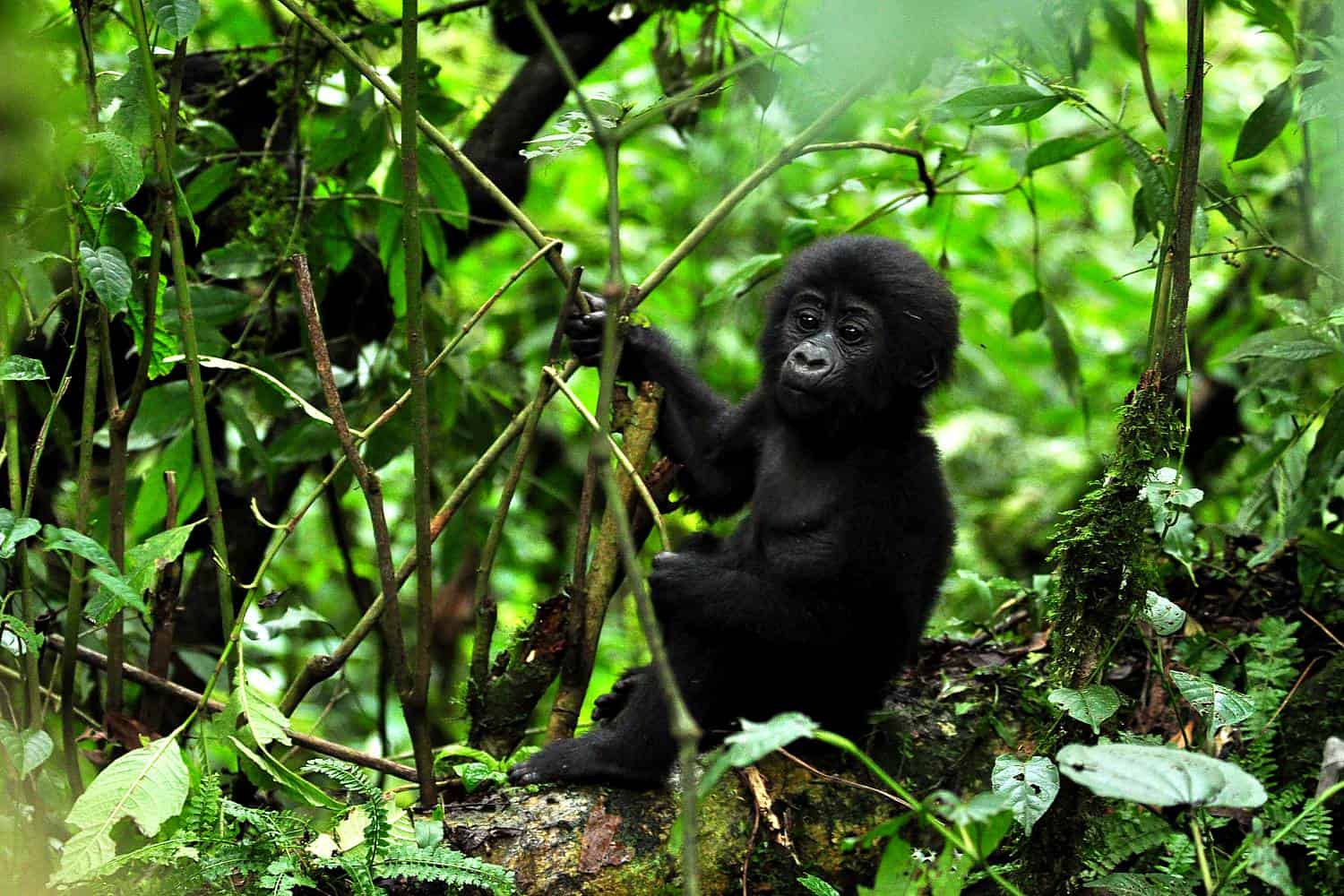 |
10. Required Fitness Levels For Gorilla Treks
Key Takeaways
- Visitors advised to have good fitness levels for navigating rough, ascending and descending terrain
- Trekking time may depend on the location of the family of gorillas assigned to you
- Acclimating by practicing trekking high altitudes before arriving in Bwindi and Mgahinga is advisable
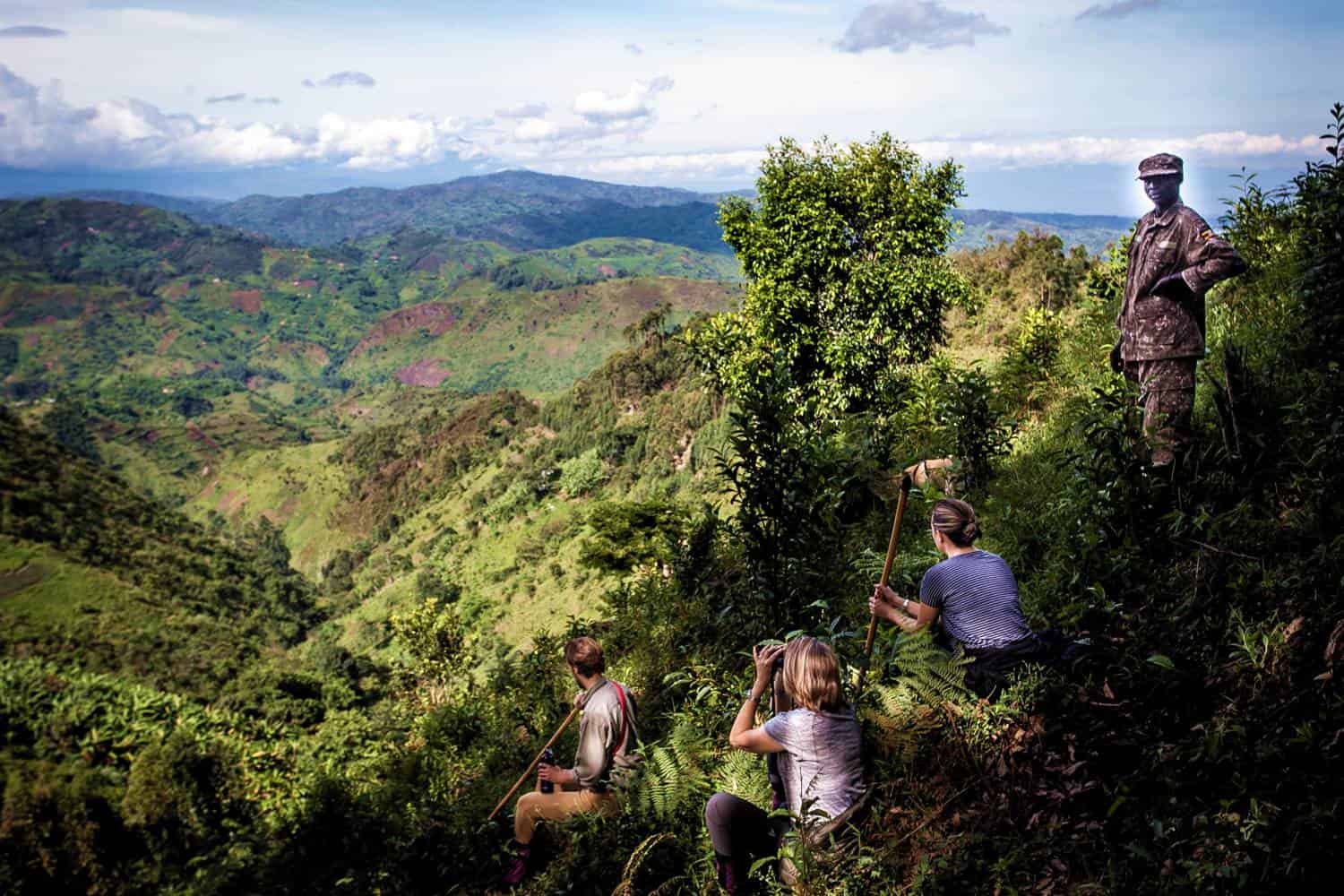 |
11. Acquiring The Necessary Permit For Your Gorilla Safari
Key Takeaways
- Around 160 permits issued each day by the Uganda Wildlife Authority
- Accurate personal and passport information necessary for acquiring permits, visitors must request the tour consultants to apply in advance
- Current price is $800 but can be raised at any time, each group comprises of only 8 guests. Permit price for the Gorilla Habituation Experience is $1500, each group consists of only 4 guests
There are a total of 20 gorilla families in Bwindi Impenetrable National Park. Of these, only 19 groups are allowed visitors — the other one is still going through the habituation process. If you would like to spend time with these two groups to understand how researchers conduct the habituation process, you can sign up for the Gorilla Habituation Experience. The current price for each permit for this trip is $1500. Only four guests (in one group) are allowed to visit the gorilla family each day. That works out to a total of just four guests per day, and permits go fast, especially those seeking luxury adventure safaris in Uganda. Regulations also require that excursions be conducted between 7 a.m. and 6 p.m. You will arrive at the trailhead at 7 a.m. and begin the trek after 7:30 a.m., after a debriefing session. Guests must return from their safari treks by 6 p.m.
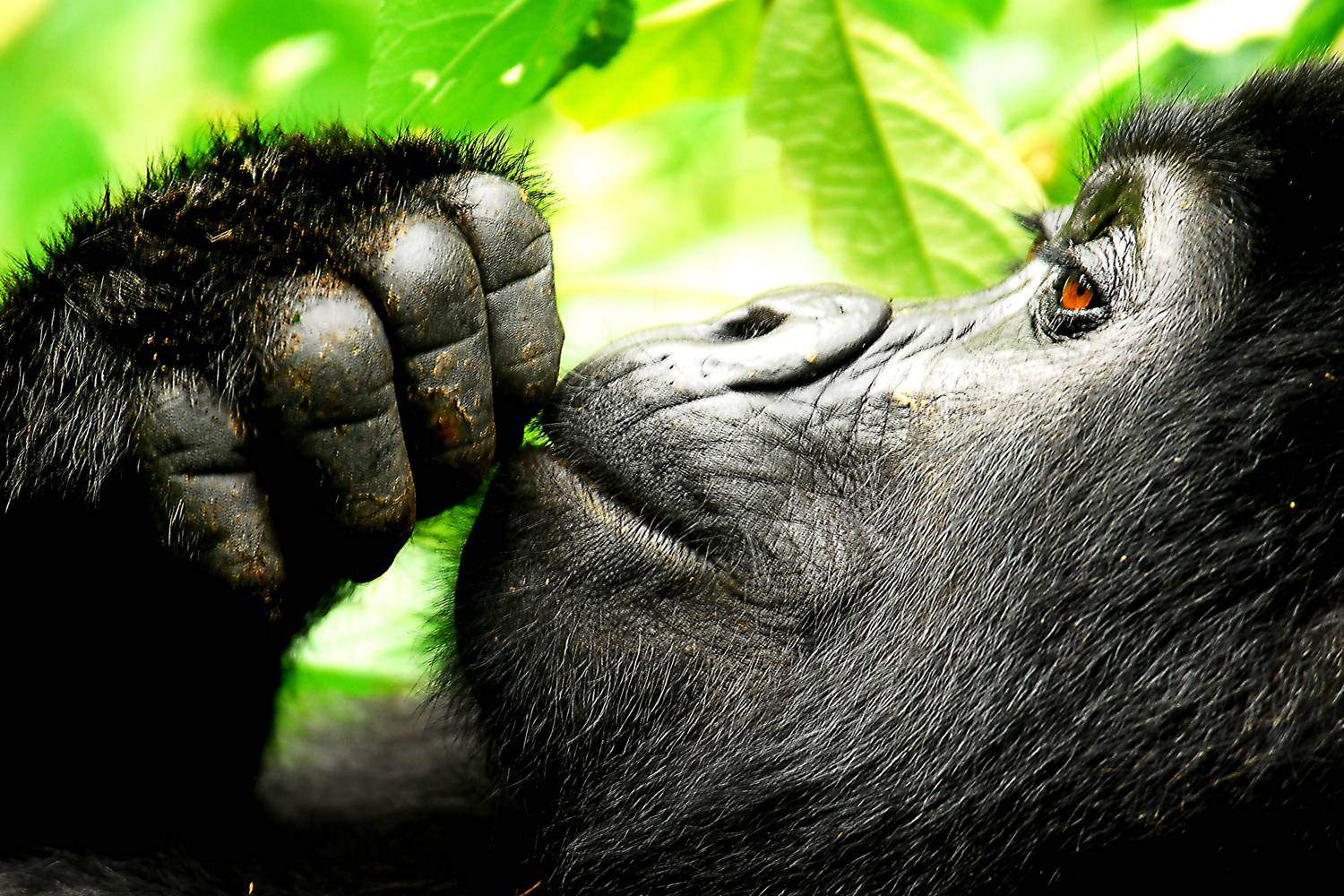 |
12. How & When Does The Gorilla Trekking Excursion Begin In Uganda?
Key Takeaways
- Guests requested to arrive at the park meet-up point at each sector at 7 a.m.
- Bring your gorilla permit, passport, and other supplies along with appropriate gear
- Traditional dancers provide entertainment and music before or after the trek
 |
13. What To Expect On Your Gorilla Safari Day In Uganda
Key Takeaways
- Gorilla families assigned according to the fitness levels of the visitors, fitter and more adventurous guests can participate in tougher and longer treks
- Movements of gorillas families unpredictable but rangers walk ahead to spot them in the forest and send back information about their location
- Porters help carry supplies and assist rangers in keeping the group safe from unexpected situations
- Trekking time can vary anywhere from 30 minutes to 8 hours depending on where the gorilla family is foraging for food and their previous night nesting location
- Spending 60 minutes sitting at a safe distance from the primates and observing their activities like feeding, napping, and grooming one another
Treks Can Be Unpredictable
There is always the possibility that the gorilla family you’re looking for has wandered far from their regular foraging locales. While this factor does make the trek exciting and unpredictable, you might want to inform your tour guide of any physical limitations.Booking the services of a porter to assist you and help carry your gear is also a good idea. Each group includes the main guide and two rangers, who are armed with guns to protect trekkers from the unforeseen dangers of the forests of Bwindi. Your guide and one ranger will walk ahead of the group, while the second ranger will bring up the rear.
Rangers Are Prepared For Most Unusual Situations
Untoward incidents are rare and there has never been an instance of shooting gorillas. If needed, however, the rangers will fire in the air to scare away animals. Further, the rangers have the necessary training to help you hide in a safe place until the danger has passed. Each morning, before the trek is scheduled to begin, an experienced tracker goes out to find the gorilla family and get an estimate of the group’s movements, so he can send directions to the tour guides. This invaluable assistance makes it a lot easier to track the primates in Bwindi Impenetrable Park.Trekking Over Rough Forest Trails
In addition to the gorillas’ location, several other factors can influence the duration of your safari trek. Weather conditions and the uphill uneven (and often muddy) terrain you are walking over can also affect how much time it will take. You may find yourself ducking to avoid low-hanging vines or grasping at branches to pull yourself along. To help you, the guide may cut away some of the bush with a machete, clearing a path. Some treks in Bwindi Impenetrable National Park may take just 30 to 60 minutes to reach the gorillas, while others can be far more strenuous and can take 5 to 8 hours in total including return time.Enjoy The Most Incredible 60 Minutes Of Your Life
Once you find the gorilla family, your guide will start the timer. You’ll have 60 minutes to watch these incredible primates as they munch on leaves and shoots, nap on the ground, climb trees, or swing from the branches. Take all the pictures you want to record their behavior, and imprint your gorilla safari holiday memories of their gentle grace, peaceful nature, and laid-back movements, which seem to belie their often massive sizes. This is truly a magical experience that you will cherish all your life — and, no doubt, having you want to come back to Africa for more.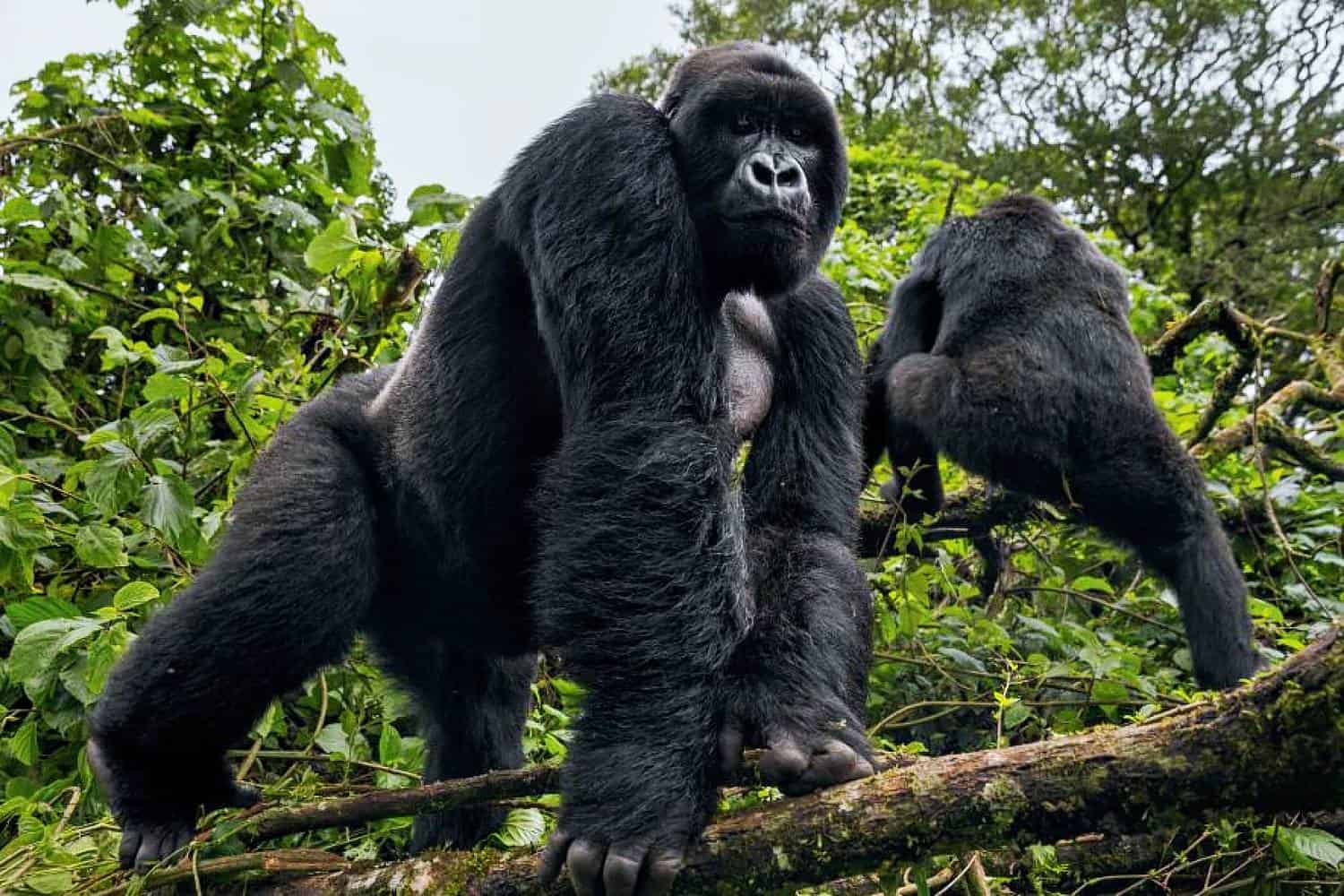 |
Select Our Highly Recommended & Unique Designed Uganda Safaris & Gorilla Treks That You Want To Tour Visit & Experience
How To Plan The Best 2026-2027 Chimpanzee Safari Treks For Uganda?
Say “Uganda” and most avid travelers will instantly think about the magnificent gorillas that live in the misty highlands of Bwindi Impenetrable National Park. However, while you’re planning your vacation in the country, the tour consultant at AfricanMecca Safaris will also talk to you about chimpanzee viewing experiences and various other primates you could enjoy seeing on your trip. The reserves and parks of this African nation abound with a range of primates, some of which are extremely rare and may not be found anywhere else outside East Africa.Chimpanzees are close relatives of the gorillas with a 1.6% DNA difference and equally exciting to watch in their endemic habitat. Humans share 96% DNA similarities with chimps. In contrast to their ape and Sapien cousins, they spend most of their time in the high treetops, sometimes coming down to the ground. Experts studying them talk about the challenges they face for survival amid poaching and destruction of their habitats.
Key Takeaways
- Opportunity to see various other primates that thrive in Uganda other than the iconic mountain gorillas
- Learning more about chimpanzees that share DNA with a difference of 1.6% from gorillas and 96% similarity with humans
- Visiting park like Kibale Forest, Kyambura Gorge in Queen Elizabeth, Budongo Forest in Murchison Falls, and Semliki, where chimpanzees are found
- Possibility of spotting more than 10 species of primates other than gorillas and chimpanzees on your Uganda tour
- Exploring the habitats of the primates and spending time with researchers as they undertake the habituation process
Page Content - Start Here
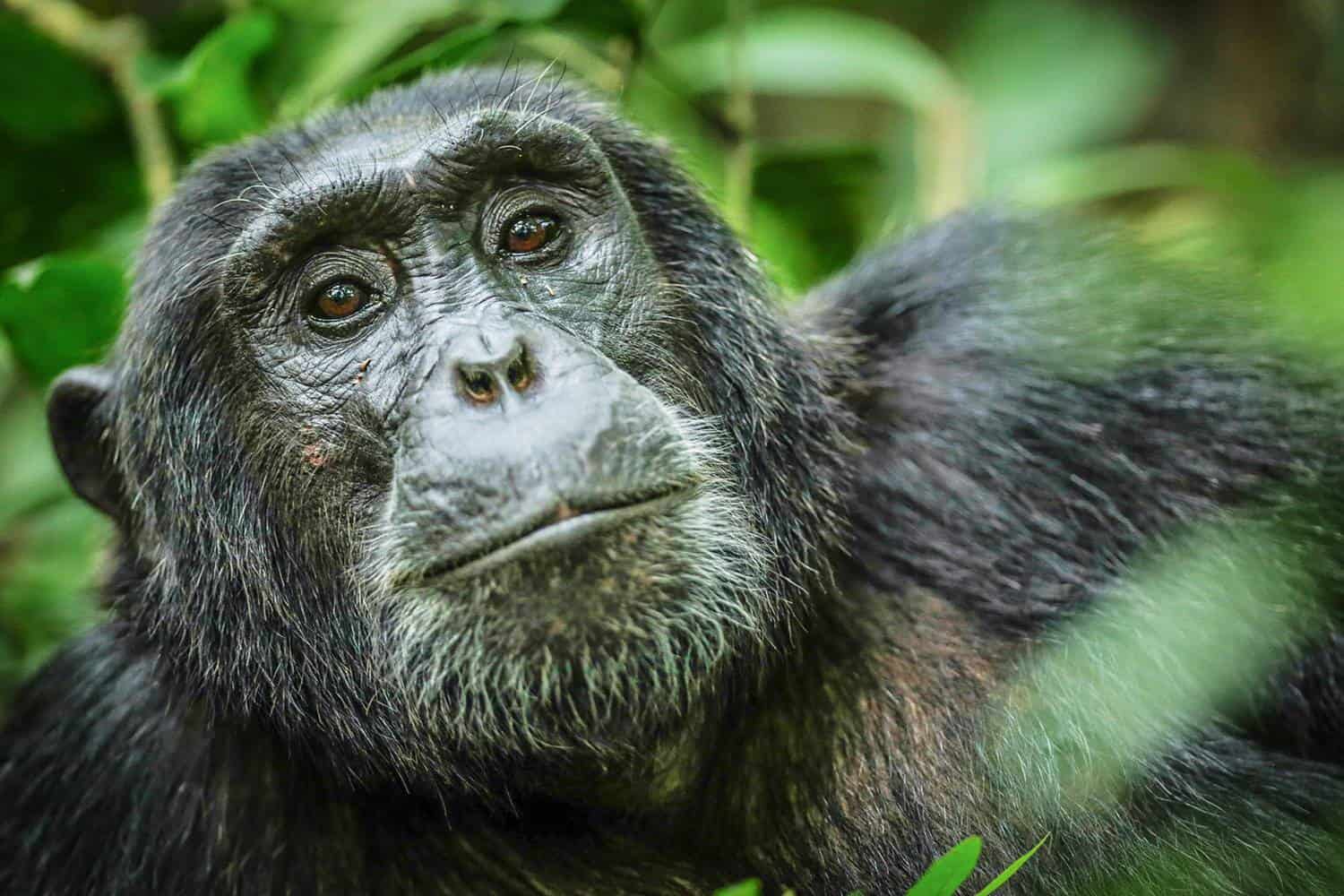 |
1. History of Chimpanzees In Uganda
Key Takeaways
- Uganda is known to be home to thousands of chimpanzees before the colonial era
- Growing human populations, difficult political conditions, indiscriminate felling of trees, and habitat destruction leading to diminishing numbers
- Threats like poachers hunting for chimps for meat and snares for other animals
The primates now also face the danger of getting caught in snares intended for antelopes and other animals hunted for food. Uganda is one of the last 21 countries in Africa that still have chimpanzees. Other parks to see chimpanzees in East Africa are Mahale, Gombe in Tanzania, and Nyungwe in Rwanda.
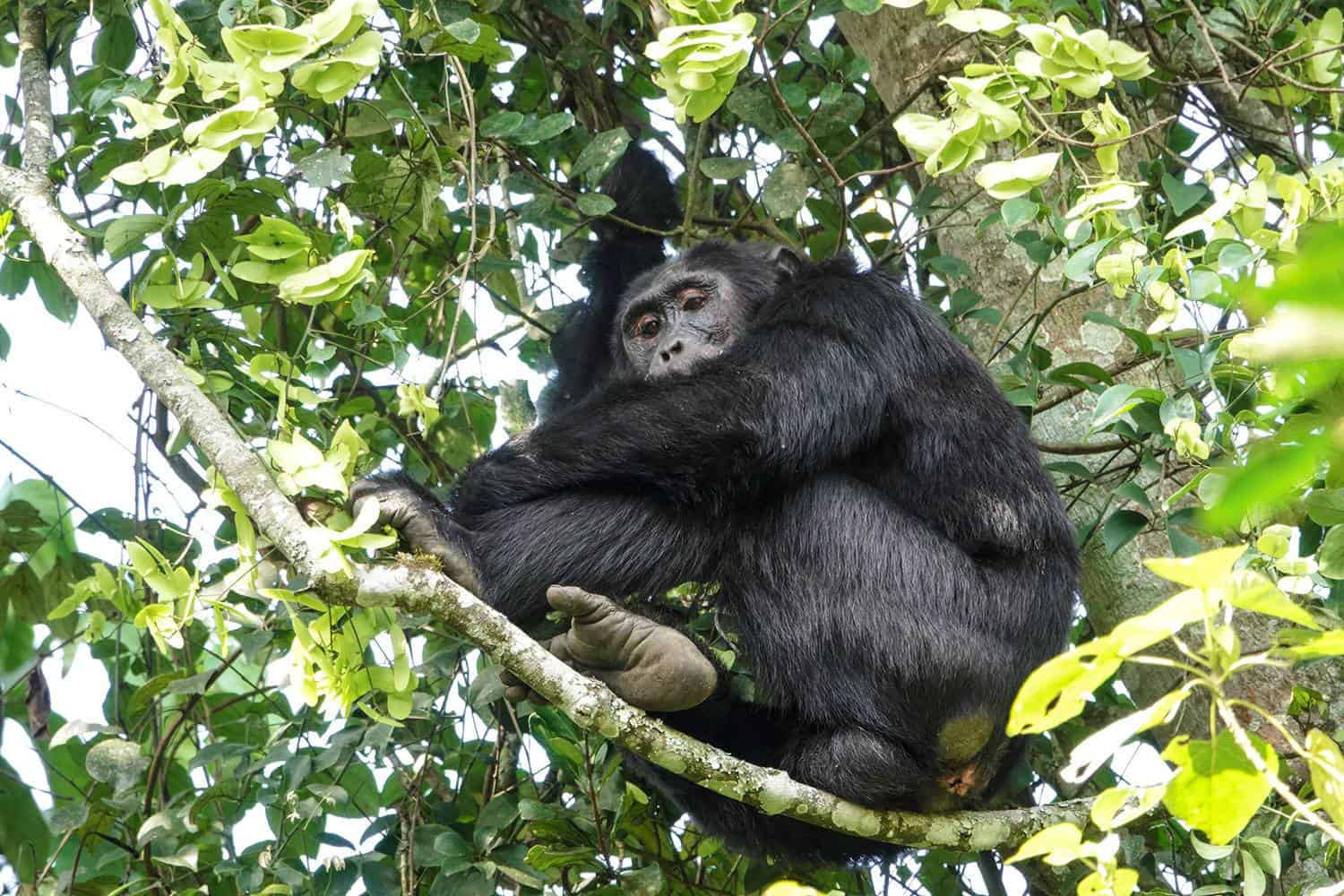 |
2. Where & Best Safari Parks To Find Chimpanzees In Uganda
Key Takeaways
- Several parks and reserves established in Uganda for the preservation of the chimps
- Tourists provided the opportunity to go chimpanzee trekking and spend an hour with them
- Participating in chimpanzee habituation experience where they are adapted to the presence of humans
You will also gain insights into how the chimp families are slowly helped to adapt to the presence of humans, to a point where they will ignore their human visitors. Once these primates are convinced that humans are not a threat, they will go about their activities as usual. To visit a family of habituated chimpanzees, you will have to procure the necessary permit in advance from the authorities for a fee.
If you would like to see the chimpanzees in their natural living conditions, you can add tours of the parks where they abound to your safari vacation itinerary. Some of the best locations include Kibale National Park, Budongo Forest in Murchison Falls National Park, and Kyambura Gorge in Queen Elizabeth National Park. Regions such as Bwindi Impenetrable National Park, Bigodi Wetlands Sanctuary, and Buniga Forest also have resident skittish chimpanzees. However, here they are not habituated to the presence of humans, which may make them more difficult to spot or track down.
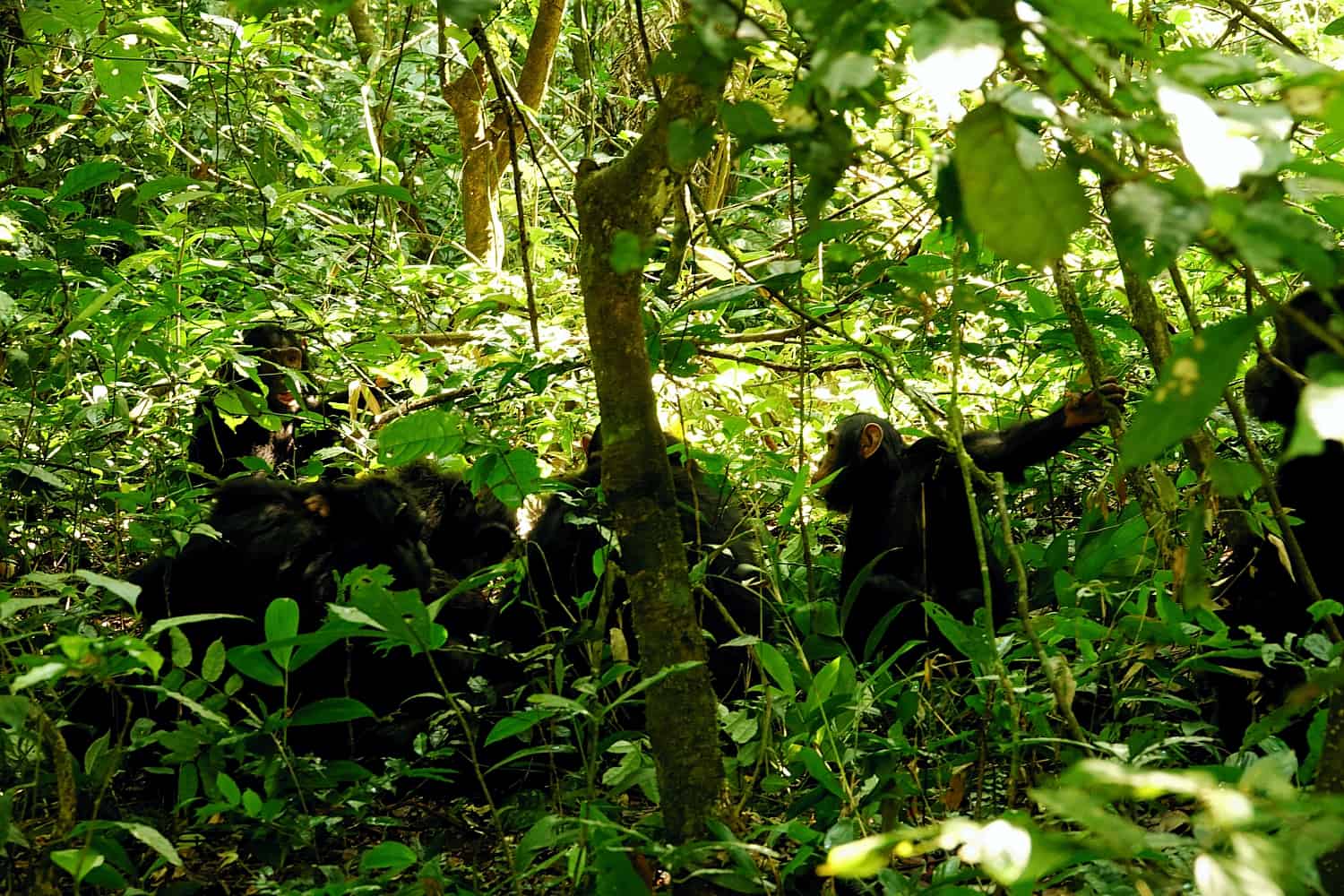 |
3. Kibale Forest Chimpanzee Safari
Key Takeaways
- Visiting with chimpanzees for an hour or joining in a habituation expedition that typically takes two years to complete
- Tourists offered the chance to spend an entire day with ranger CHEX researchers
- Possibility of spotting other primates that also thrive in the Kibale Forest
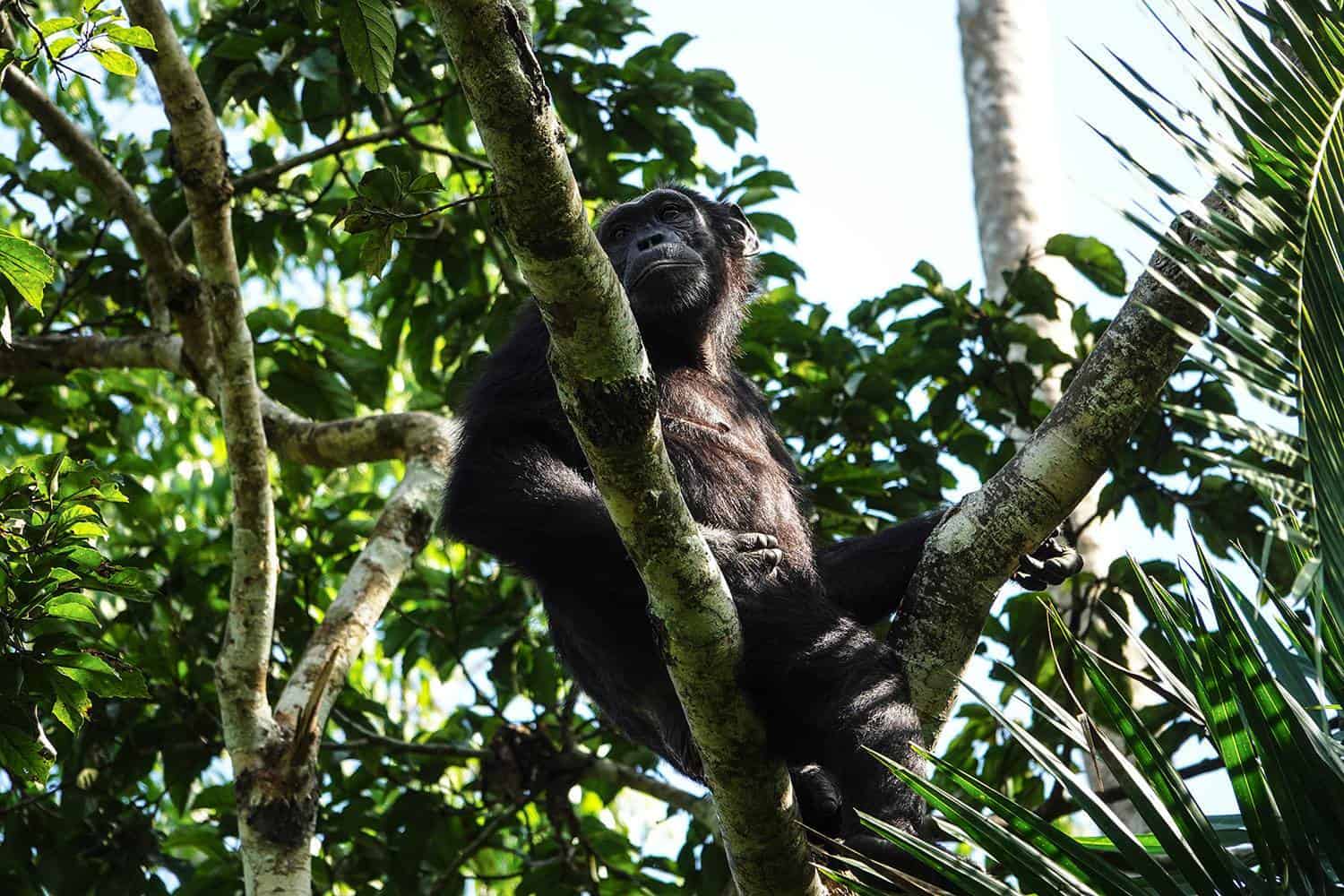 |
4. Tracking Down Chimpanzees Of Kyambura Gorge In Queen Elizabeth
Key Takeaways
- Traveling through the Kyambura Game Reserve, a buffer zone for chimpanzee conservation in its gorge
- Known to be the site of the famous BBC feature, “Chimps of the Lost Gorge”
- Trekking tours lasting for around 2 to 3 hours in the Eden-like environs of the forests
You can sign up for a 2-3-hour trekking trip into the gorge, where you will be treated to the immense beauty of its verdant environs. A bonus is spotting many species of colorful avian life and other smaller fauna thriving in the unique biome. There is also an opportunity to see a different chimpanzee family thriving in the Kalinzu Forest, around half an hour’s drive from the luxurious Kyambura Gorge Lodge.
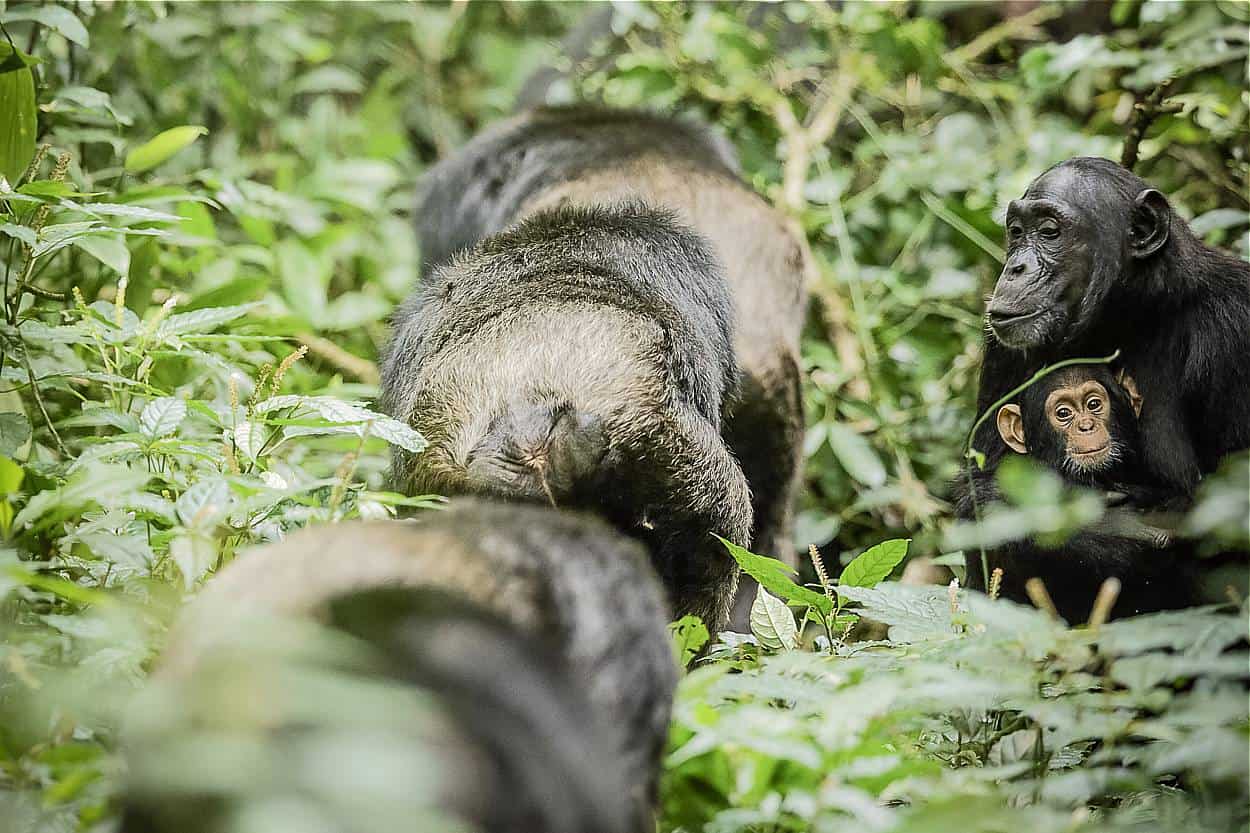 |
5. Chimpanzees & Primate Treks At Budongo Forest In Murchison Falls
Key Takeaways
- Traveling to the Kaniyo Pabidi forest, a stunningly beautiful verdant region home to communities of 600 to 800 chimpanzees
- Sightings of various other primates and smaller fauna
- Traversing the forest area spotting flora species, butterfly varieties, and diverse avian life
Kaniyo Pabidi has various other treasures in store for you, including several other primate species, such as olive baboons, beautiful black and white colobus monkeys, vervet monkeys, and blue monkeys. Using the luxurious Baker’s Lodge as your basecamp; you can plan primate trekking safari trips or birdwatching tours for sightings of rare species like the white-thighed hornbill, Puvel's illadopsis, and chocolate-backed kingfisher.
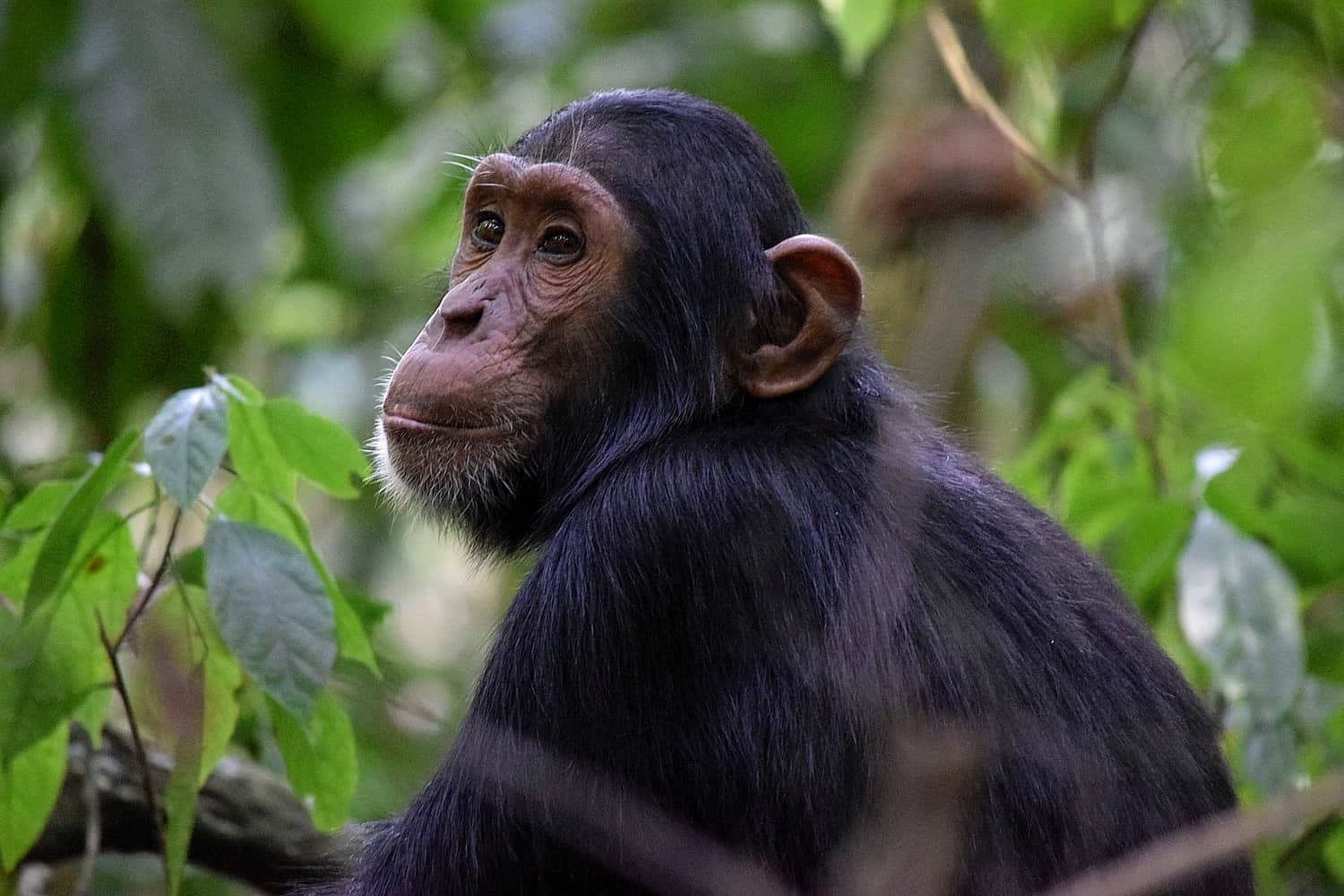 |
6. Chimpanzees Of The Semliki Project
Key Takeaways
- Semliki Chimpanzee Project developed by Indiana University Professor Kevin Hunt in 1996
- Focus of the project to research and study the habits, behavior, and social structure of the chimpanzees of the Toro-Semliki Reserve
- Conservation program operates in conjunction with ranger patrols to deter poachers and remove snares designed to capture the chimps and sell them for meat
By studying their methods for building sleeping platforms or nests in the trees, the researchers attempted to gather clues about the chimps’ social structure, family sizes, and different aspects of their actions. Although the team spent their days researching all the individuals of the locale, they paid special attention to the Mugiri Community that was mainly found in the center of the reserve.
Today, the conservation efforts being undertaken to protect the chimpanzees are truly admirable. The authorities have initiated several programs to prevent illegal and suspicious activities that threaten the primates. Rangers are tasked with eliminating signs of human activity, removing snares, and deterring poachers. The presence of researchers and ranger patrols have been fairly successful in helping the chimpanzees thrive without fear.
At present, three or four separate chimpanzee communities have been detected in the Semliki Reserve, such as the Mugiri, Wasa, Nyabaroga, and Muzizi. The Mugiri community is often seen along the banks of the Mugiri River and its tributaries, while the Muzizi community is spotted around their namesake river. The Nyabaroga Valley and its forests seem to have their own chimpanzee presence, and some individuals have been identified along the Wasa River, identified as possible members of the Mugiri family.
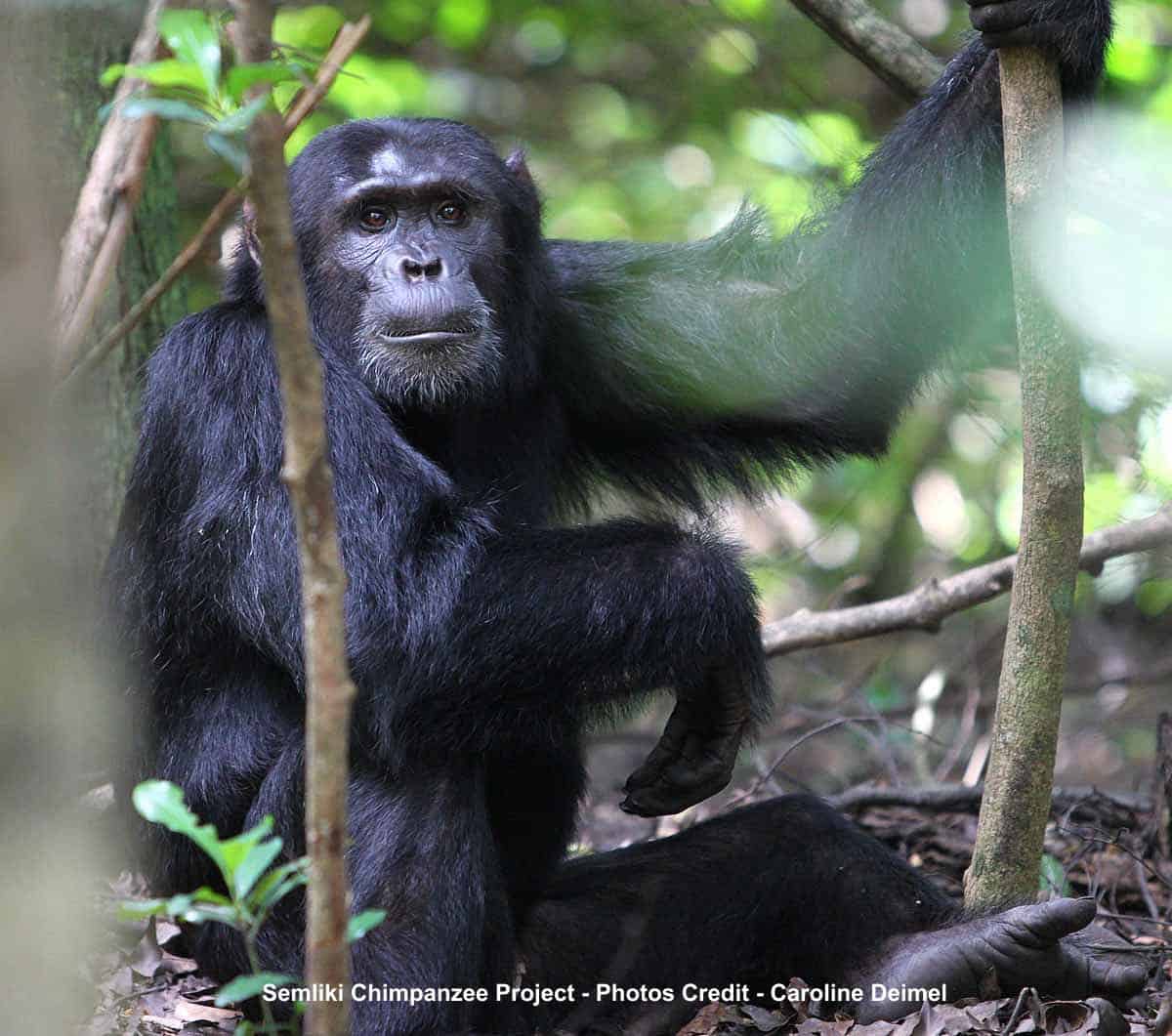 |
7. What Is The Chimpanzee Viewing Safari All About In Uganda?
The Chimpanzee Trekking Experience In Uganda - Everything You Need to Know
Encountering the chimpanzees in Uganda can be a truly life-changing experience. Read on for answers to the most frequently asked questions regarding this incredible primate holiday excursion.Key Takeaways
- Over 5000 chimpanzees known to live in the parks of Uganda of which some families have been habituated
- Ongoing research programs since 1987 where scientists observe and study families from a safe distance
- Habituation in always in progress on a few select chimp communities
- Visitors can also participate in the Chimpanzee Habituation Experience called CHEX
- Opportunity to interact with primate researchers and listen to them talk about the need for conservation and how their studies are conducted
Missions Of The Research Projects
Research on the Pan troglodytes schweinfurthii, the Eastern chimpanzee genus inhabiting Kibale National Park, was first initiated in 1987. This project was named The Kibale Chimpanzee Project (KCP) and directed by Dr. Richard Wrangham. The KCP is researching the Kanyawara community, which has about 60 individuals. Meanwhile, the team of scientists composed of Kevin Langergraber from Arizona State University, David Watts from Yale University, and John Mitani from University of Michigan have been working on the Ngogo Chimpanzee Project since 1995, which studied 200 of these primates in Kibale. The third group at Kanyanchu is also open to visits from tourists, while the fourth group, in Sebitole, is targeted for research.Similarly, Budongo Forest near Murchison Falls National Park has the Budongo Conservation Field Station (BCFS) project that was instituted in 1990 by Professor Vernon Reynolds. He has been studying chimps since 1962, and is an excellent authority on this primate subject matter. Jane Goodall Institute was one of the first to support BCFS. There are smaller research projects in Queen Elizabeth National Park (Kyambura Gorge) and Semliki Wildlife Reserve (chimpanzees of Semliki)
As you spend time with the chimps, your primate guide will talk to you about how they focus on the physiology, preferred habitat, and behavior of the animals from the perspective of conserving and protecting them. The tracking experience is all about viewing these amazing creatures in their natural homes, and you can watch them swing in the trees, look for food and occasional hunting, care for their young, mating, and survey their territories. Like-minded tourists typically come away entranced by their encounter and with a better understanding of the need to conserve these intelligent and human-like animals with a shared 96% DNA.
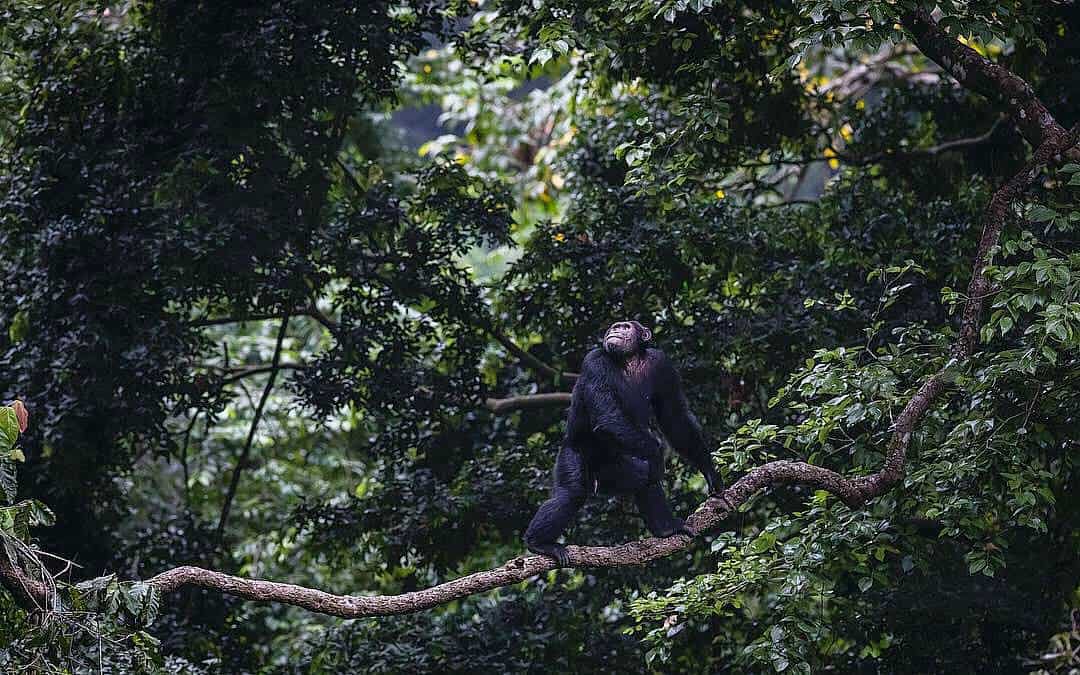 |
8. How Do You Get A Permit for Viewing The Chimpanzees In Uganda?
Key Takeaways
- Around 24 permits issued by the Uganda Wildlife Authority per day in Kibale with the objective to protect primates from contracting human illnesses. Fewer are issued in Budongo, Kyambura Gorge and Semliki.
- Visitors desiring to track chimpanzees need to inform the tour consultant at AfricanMecca ahead of time to guarantee your permit availability and issuance.
- Copy of passport for identification required for applying for the permits
Because of the limited number of permits available, you’ll want to contact your tour consultant at AfricanMecca Safaris well in advance and advise them of your wish to participate in the normal chimpanzee trekking safari in or the Chimpanzee Habituation Experience, also called CHEX in Uganda . They will secure the necessary permits for your preferred travel date in your preferred chimp parks in Uganda. To acquire the permits, you will be asked to send in a copy of your passport bio page for the purpose of identification and issuance of the permit. You can choose from treks that leave twice a day – in the morning at 8 a.m. or in the afternoon at 2 p.m.
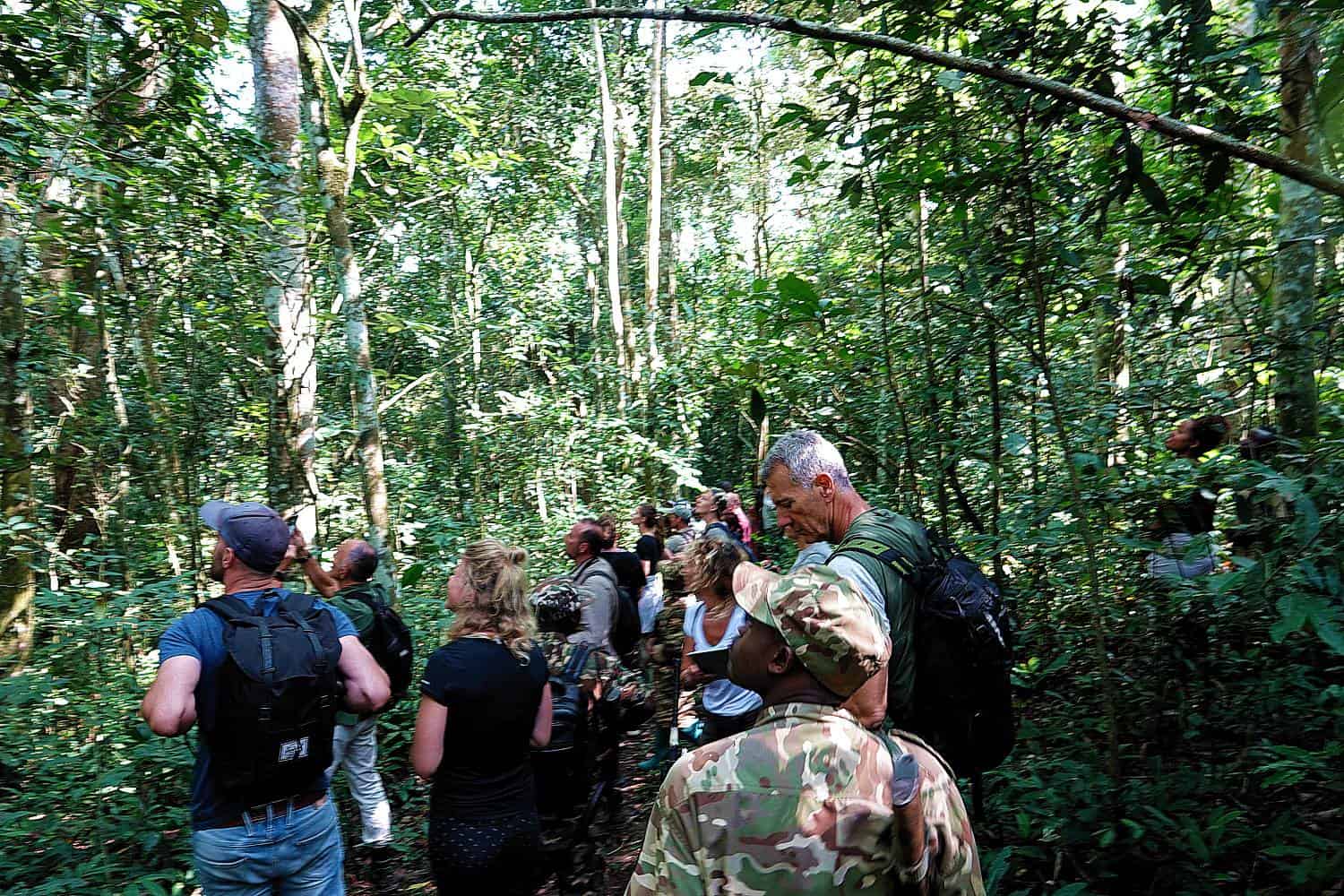 |
9. What Are The Recommended Fitness Levels For The Trek?
Key Takeaways
- Hiking over flat to uneven, hilly terrain for 2 to 3 hours for the habituated treks
- High probability of encountering the targeted chimpanzee family
- Visitors may wish to come prepared for a full day’s trek on CHEX
You don’t need exceptional fitness levels to navigate the trails, and the trek is similar to a less demanding forest hike. However, if you wish to sign up for CHEX, you should come prepared for an entire arduous day of trekking in the forest environs. Some visitors find the normal chimpanzee tour more enjoyable than the Chimpanzee Habituation Experience safari, because you aren’t tired out by the time you reach the spot where the chimps are hanging out primarily high on the trees or following them intensely as they move around over long distances.
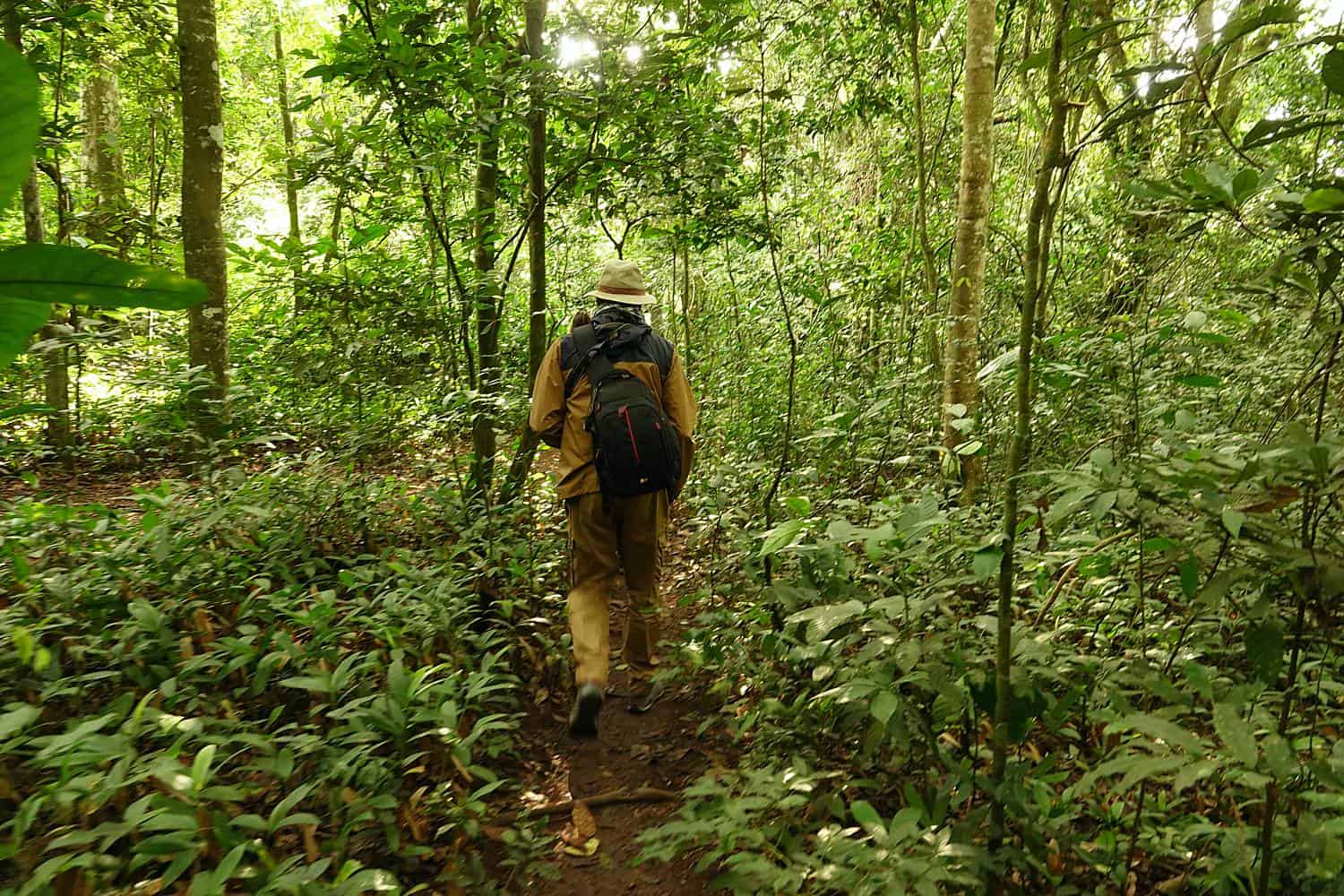 |
10. What Essential Items Are Needed For The Chimp Excursion?
Your consultant at AfricanMecca Safaris will recommend that you have these items along for your primate trip:- Sturdy walking boots
- Full-sleeved shirt and long pants, preferably tucked into your boots
- Light rain jacket and hat for protection against unexpected showers
- A sturdy walking stick
- Backpack with a snack and adequate water (at least 1 liter to prevent dehydration)
- Packed lunch (provided by the lodge or camp where you’re staying)
- Gardening gloves for protection against thorny bushes
11. What Are The Rules For Chimp Photography In Uganda?
Key Takeaways
- No restrictions on photography for tourists wanting to take mementos of their trip
- Visitors may want to come prepared for the chimps moving quickly through the trees
- Turning off the flash and clicking sounds is mandatory
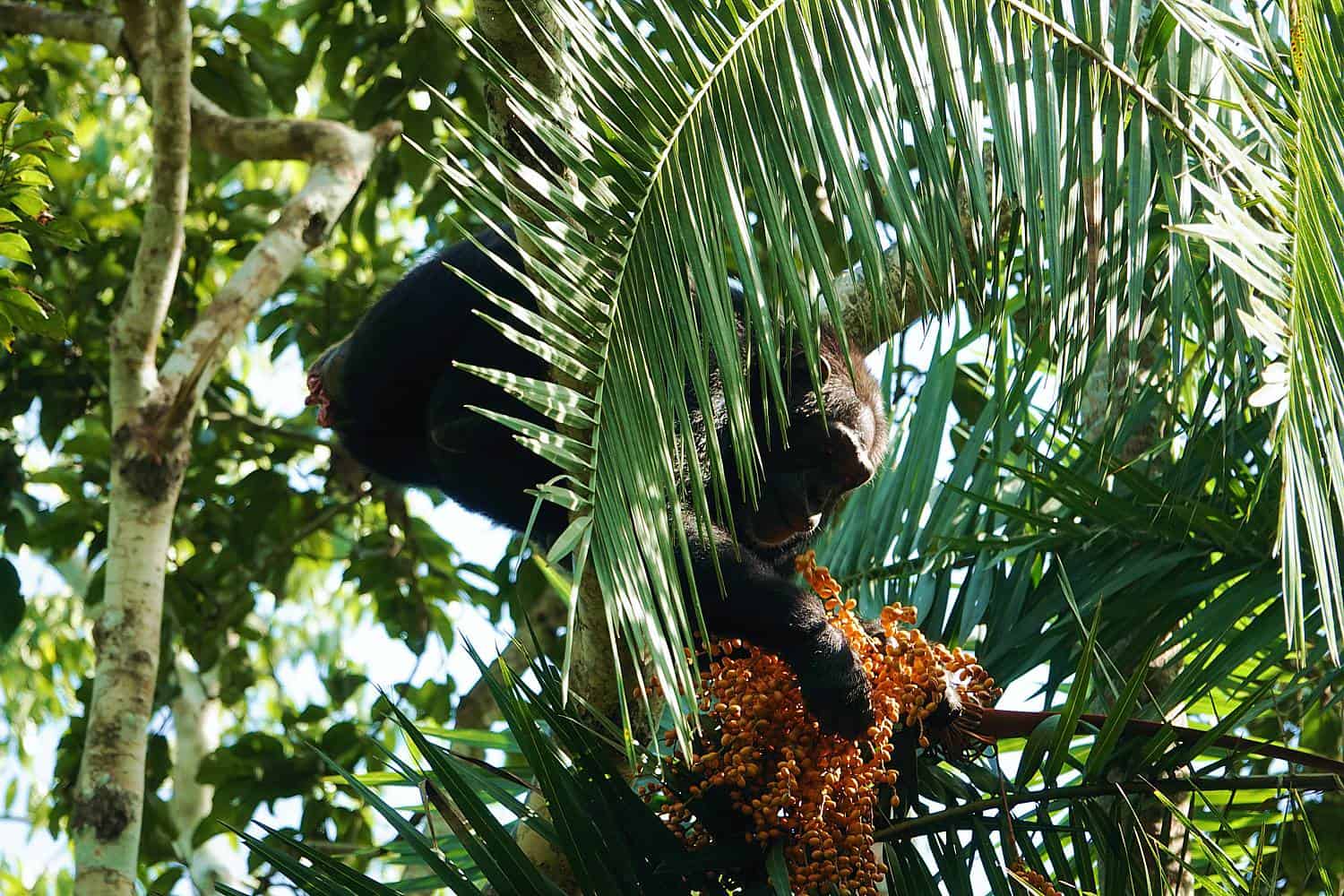 |
12. Chimpanzee Safari Regulations By The Park Authorities In Uganda
The Uganda Wildlife Authority (UWA) has laid down several regulations intended to protect the unique chimp denizens and the wildlife lovers who come to visit them. You will receive an orientation session by the park guides and rangers before you leave for your trek. It’s advisable that you follow the do’s and don’ts carefully.- Given that the chimpanzees are in their natural habitat, the probability of sighting them depends on factors such as the availability of their favorite food and weather conditions. However, you can expect to have a high probability of seeing them.
- You will have an expert ranger guide accompanying you, and it is essential to stay close and follow all the instructions you are given.
- Each group of travelers may have only 6 to 8 people.
- Once you sight the chimpanzees, you can spend just 60 minutes with them. If the guides sense that the chimps are stressed or uneasy with the human presence, they might choose to cut short your time.
- Tourists must take care to maintain a distance of 8 meters from the primates. If they approach you, move away slowly without making any sudden movements.
- The chimpanzees may descend from the trees and walk on the ground. Please do not follow them.
- The minimum age for visitors to track the chimps is 12 years.
- Eating and drinking in the presence of the chimpanzees or any other primates is strictly prohibited.
- If you have any kind of illness, do not enter the park or participate in the chimp trek as you can endanger the primates by transmitting your ailment.
- Make sure to come appropriately dressed for your excursion.
- Do not make loud noises, talk loudly or shout in the forest.
- You can hire a porter to help you carry your backpack and other equipment.
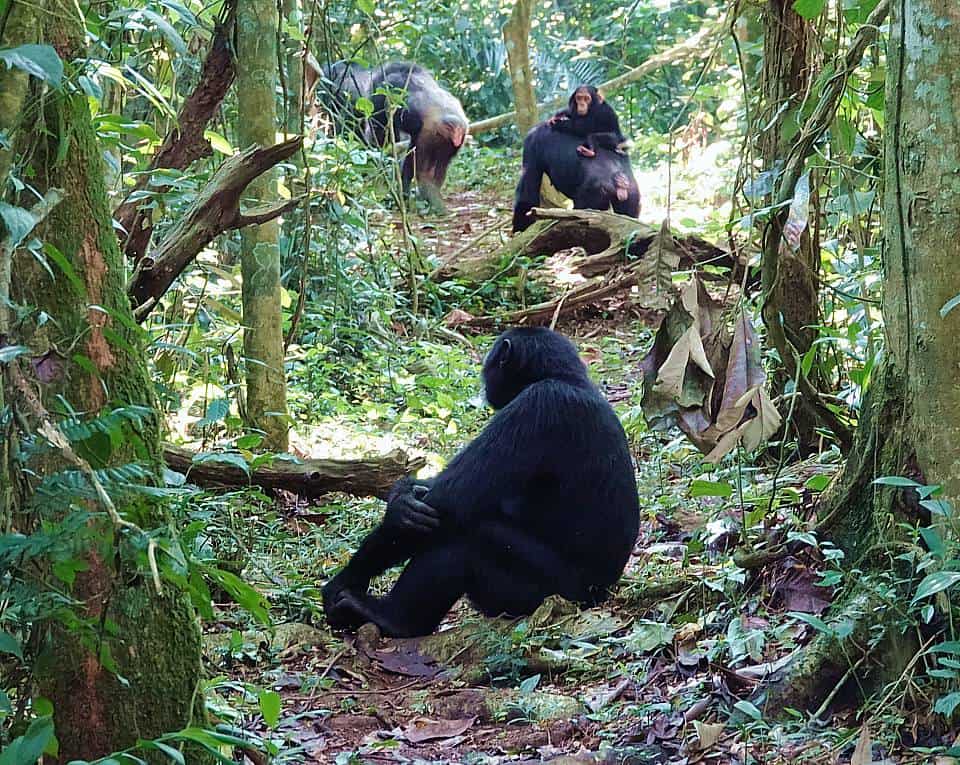 |
13. How Does The Chimpanzee Viewing Trek Work On The Day?
Key Takeaways
- Morning 8 a.m. or afternoon 2 p.m. trek for tracking chimpanzees. Full-day trek for the Chimpanzee Habituation Experience (CHEX) starts at 7 a.m.
- Short orientation before starting the trek, possibility of sighting up to other species of primates that live in the forest reserves
- Opportunity to spend 60 minutes observing chimpanzees in the trees from a distance of 8 meters. Memorable chance to interact with primate guides and researchers and ask in-depth questions about the behaviors and habits of the primates
How The Chimp Trek Progresses
You will have an experienced and armed ranger guide accompanying you. As you travel along the trails, look out for the other species of primate present in the park, as well as some of elusive mammal and bird species that live in the forests of Uganda. You may also receive a lesson in identifying the various tree and plant species and their medicinal properties. Once you reach the family of chimpanzees assigned to your group, the guide will signal you to stop at a distance of 8 meters away from them. You’ll be able to spend the next 60 minutes watching them swinging in the trees, munching on fruits and other edible items, grooming each other, feeding the babies, mating, or napping. If you are lucky, you may be able to experience chimpanzees hunting down monkeys and smaller fauna.CHEX - A Habituation Excursion
If you have signed up for CHEX, feel free to ask the park researchers more in-depth questions as you try to understand chimpanzee behavior, their mating rituals, and their family hierarchy (an alpha heads the group) on a full day tracking and viewing experience. Listen to the sounds of chimps screeching and thumping on tree trunks echoing through the forests. Your primate tour guides will explain that chimpanzees communicate with one another by hitting the trunks and branches of trees. Watching these primates can be a very dramatic activity, since they are more animated and active than gorillas. Note, though, that they are also more likely to remain in the higher levels of the trees and descend to the forest floor only occasionally and also when traversing over long distances.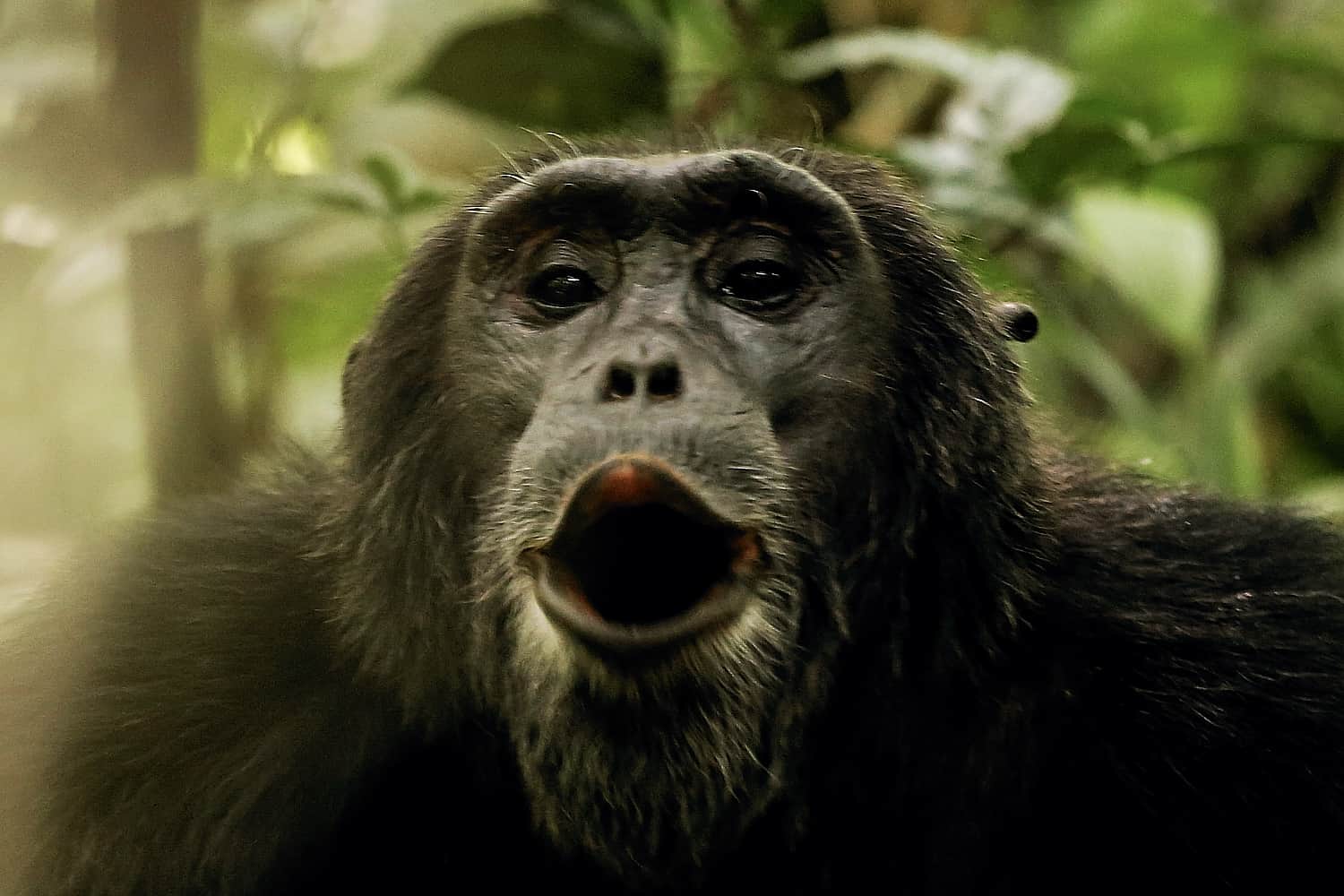 |
14. Golden Monkeys Trekking Safari In Uganda
Key Takeaways
- Tracking the rare, endangered golden monkeys also facing similar challenges for survival like mountain gorillas
- Preferred habitat in the upper branches of the bamboo forests, occasionally found on the forest floor
- Each group comprising 80 to 100 individuals that are constantly on the move
As you will learn on your vacation, these primates are related to the Sykes’ monkeys and frequent the higher altitudes of Mount Gahinga. Each group of golden monkeys is comprised of about 80 to 100 individuals, who are constantly on the move. They are intensely curious by nature and will examine you just as closely as you observe them. While taking photographs can present something of a challenge when they’re high in the trees, on some occasions, tourists have found the monkeys on the forest floor. They are enchanting beings and will delight you with their behavior and inquisitive looks.
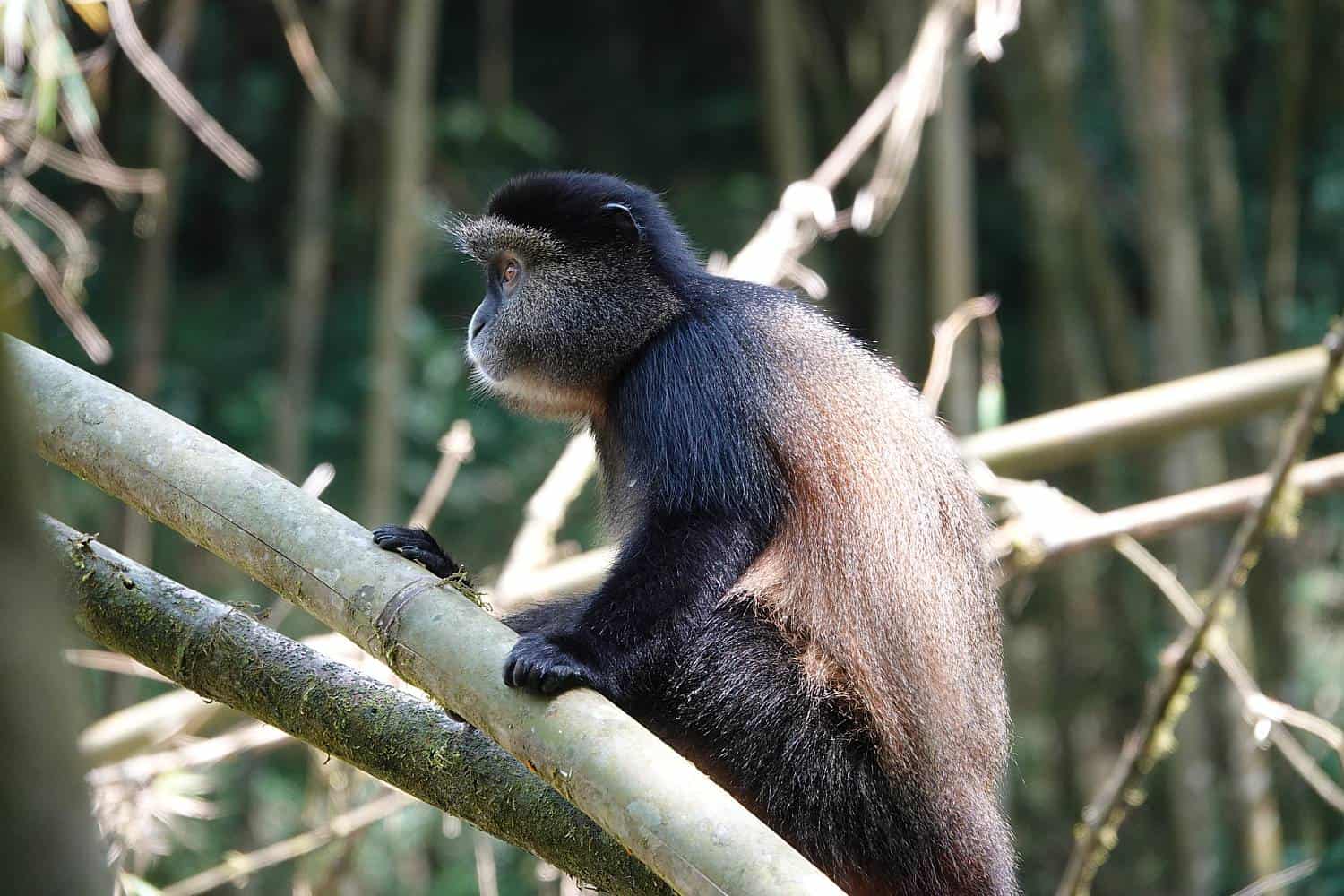 |
15. Viewing The Other Primates Of Uganda
Key Takeaways
- Aside from chimpanzees and mountain gorillas, various other primate species known to thrive in Uganda, research indicates more than 10 different species
- Viewing the very rare and unique golden monkeys found in the bamboo forests of Mgahinga Gorilla National Park
- Black and white colobus monkeys, so named because of their lack of thumbs, common to most other primates
Incidentally, the word “colobus” means mutilated. The monkeys received this name because they have no thumbs. It might also interest you to know that the babies of black and white colobus monkeys are born completely white but develop their darker coloring as they grow older.
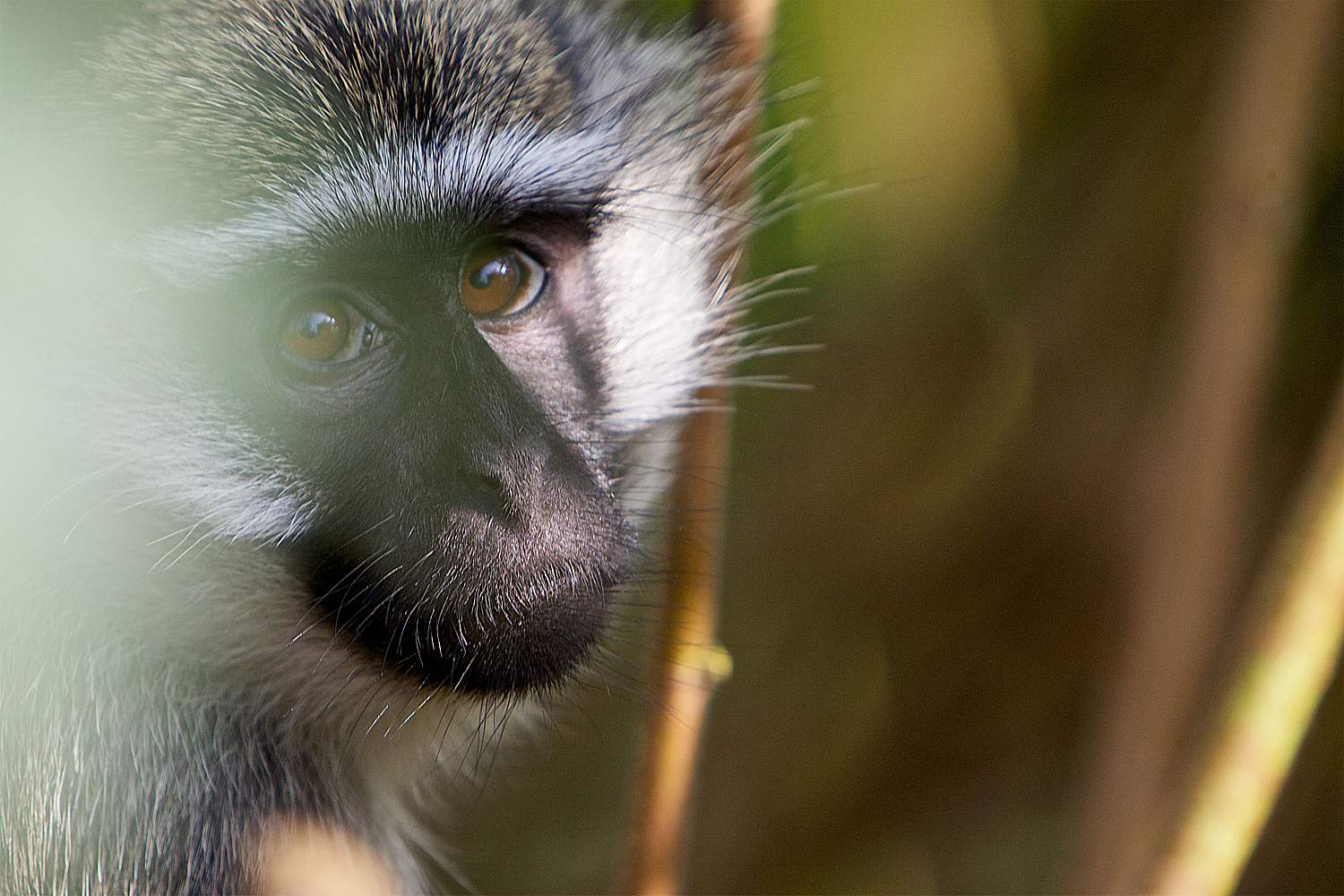 |
Select Our Highly Recommended & Unique Designed Uganda Safaris & Gorilla Treks That You Want To Tour Visit & Experience
|
Uganda Country Rating By AfricanMecca
4.3
Star
Attractions Exclusivity Activities Accommodations Authenticity
Users
(0 votes)
0
|
Learn More On AfricanMecca Safari Tier Ratings & Experiences |
Write A Trip Review For Your Gorilla & Chimpanzee Safari Treks In Uganda
Read More +
WILDLIFE SAFARIS IN UGANDA
Uganda may not boast large numbers of wildlife; however, it more than makes up for that by offering diverse sightings of the rarest and most beautiful of forest primates, savannah mammals, reptiles, amphibians, birds, insects, and others.
Read More +
UGANDA GORILLA TREK & CHIMPANZEE SAFARIS
The playful antics and heartwarming social behaviors of mountain gorillas and forest chimpanzees capture people's minds. AfricanMecca is proud to offer an insightful and enchanting trip into Uganda's primate habitats.
Read More +
CUSTOM-PRIVATE UGANDA SAFARIS
Flexibility is important during your wilderness trip to Uganda so as to ensure an intimate, personal experience. A tailor-made and private tour can be arranged for any guest regardless of their preferred safari tier.
Read More +
HONEYMOON SAFARIS IN UGANDA
A honeymoon is a special time in the lives of newlyweds. There is no more memorable place to mark new beginnings than the pristine wilderness of Uganda, with its magnificent and truly unique denizens.
Read More +
FAMILY SAFARIS IN UGANDA
Uganda is the perfect active-adventure destination to unleash your child's imagination, especially for 15+ year teens old enough to participate in gorilla-primate treks and other unique wildlife safaris.
Read More +
LUXURY SAFARIS IN UGANDA
We understand your requirements when you talk about fulfilling your dream of the ultimate luxury vacation experience in Uganda where your every bespoke and plush needs are carefully catered to.
Read More +
PHOTO SAFARIS IN UGANDA
AfricanMecca hand-selects the Uganda photography instructors we provides to our guests. These can be expert photographers and exclusive encounters, and can be offered as part of a group or privately.
Read More +
CULTURAL SAFARIS IN UGANDA
Uganda is home to 65 tribal groups. We highly recommend setting aside some time during your wilderness safari adventure to visit cultural communities and experience Uganda's traditional way of life.
Read More +
UGANDA BUSH WALK, HIKE & TREK
Uganda is a bush walking, hiking and trekking paradise, offering amazing trails for every experience level. AfricanMecca arranges safari walks, hikes and treks in the top-notch protected parks, forests and mountains.
Read More +
BIRDING SAFARIS IN UGANDA
Uganda is home to some of the most beautiful avian fauna in the world, and one of the most favored destinations for birding in Africa with more than 1000 bird species, offering our guests a superb birding safari.
Read More +
WEDDING SAFARIS IN UGANDA
Uganda promises an inimitable escape that few venture to. It appeals to brides and grooms who want the most extraordinary nuptial celebrations with all the romance of an exotic and unique safari setting.
CONTACT AND TALK TO OUR SAFARI EXPERTS TODAY TO KICK-START YOUR TOUR PLANNING PROCESS
Request Uganda Custom Or Tailor-Made Safari Pricing Based On Your Specific Travel Dates At Your Preferred Safari Tier Camp Or Lodge
CONTACT AN EXPERT ON UGANDA SAFARI PRICES & TOURSRead More +
SAFARI PRICES FOR UGANDA
Review individual itineraries and prices of our suggested Uganda safaris with the option of customizing your Africa tour based on your needs and preferences.
Read More +
HOW TO PLAN UGANDA SAFARI?
How to plan Top 11 Uganda safari trips from gorilla and chimpanzee primate treks, photographic, family, romantic honeymoons tours to hiking trails, birdwatching, luxury tour, private and custom tour.
Read More +
PARKS & RESERVES IN UGANDA
Review information on wildlife safari parks, reserves and lakes in Uganda i.e. Bwindi, Queen Elizabeth, Kibale, Murchison Falls, Kidepo Valley, Mgahinga, Semliki, and Lake Mburo
Read More +
ACCOMMODATIONS - LODGES, CAMPS, HOTELS IN UGANDA
Review information on safari lodges and camps, city hotels, lakeside resorts in Uganda's pristine wilderness, cities, lake beach shores and idyllic forests.
Read More +
BEST TIME TO VISIT UGANDA ON A SAFARI VACATION
Review details on the best time to go to Uganda to visit its various wildlife outback, forests, beachside lakes, cities and towns, mountains and other wildernesses.
Read More +
UGANDA GORILLA TREK & CHIMPANZEE SAFARIS
Experience the opportunity to track down endangered mountain gorillas of Bwindi and Mgahinga National Parks and other primates like chimpanzees and monkeys of Kibale, Kyambura Gorge, Budongo and Semliki.
Read More +
UGANDA COUNTRY PROFILE
Review country information and travel tips on Uganda i.e. geography, culture, history, climate, tipping guide, what to pack and wear, entry requirements and more.
Read More +
TOP 10 REASONS TO VISIT UGANDA
There are infinite reasons to visit Uganda e.g distinct gorilla and chimpanzee parks, one stop affordable safari destination, big game and birding paradise, diverse activities, mountain climbing etc.
Read More +
AFRICAN SAFARI PRICES
Check out safari prices and itineraries for parks and reserves in other African countries e.g. Tanzania, Kenya, Rwanda, Botswana, South Africa, Zambia etc. Namibia, Mozambique, Malawi and Zimbabwe are available on request.
AFRICANMECCA REVIEWS
What are our Customers saying about us? READ MORE REVIEWS
I just returned from a month in Africa, specifically Rwanda & Kenya. I am left breathless with my experience. AfricanMecca Safaris coordinated the entire trip for me and left no detail, nothing for me to do.
Carol Bobb - Pennsylvania, United States
Rwanda was amazing. The accommodations, food, and guides AfricanMecca arranged were great. Raza also helped us through the complicated process of getting permits for gorilla trekking. AfricanMecca is a fantastic company to work with.
Stephanie Weir - United States
Jambo Altaf and Raza! We are back on earth now after our fabulous honeymoon. This is to say THANK YOU so much for organising a week in Kenya that we will never forget.....!
Dr Krina Zondervan, Oxford University - United Kingdom
Jambo Raza!!! The safari trip was spectacular! Everything went off without a hitch. We loved the Masai Mara. The migration was awesome. You listened to what I wanted and delivered it perfectly.
Judi & Chaim Platt - Toronto, Canada
I cannot say enough about the quality of AfricanMecca. Their teams in Kenya and Tanzania were top notch. Raza, again thanks to you and your entire organization! We will be repeat customers.
Dan Kobick - Managing Director, PricewaterhouseCoopers - New York, United States
AfricanMecca Safaris offers incredibly knowledgeable and skilled services! Our travel arrangements for 2 months of volunteering with TEACH Rwanda in country were made quickly and economically. Honored to work with Raza!
Janet Brown - TEACH Rwanda Founder - United States
This is to let you know my guests, The Bryant's, had a wonderful time on the trip Samburu, Masai Mara/Kenya, Chobe/Botswana & Victoria Falls/Zambia. Everything was perfect! Thank you..
Christine Milan - MT Carmel Travel - Connecticut, United States
EAST AFRICA SAFARI BOOKING & TOUR HOLIDAY IDEA UGANDA FOR 2026-2027
We recommend visiting Bwindi for your gorilla safari trek, and combining it with Queen Elizabeth, Murchison Falls, and Kibale (chimpanzee safari) alongside your city tour visits of Kampala and Entebbe.
You may optionally extend out to other wilderness areas such as Mgahinga to track down golden monkeys and gorillas in the same park, Jinja for whitewater rafting on the Nile River, and Semliki, Lake Mburo or Kidepo for an offbeat wildlife tour.
You can end your vacation on the beach at Lake Victoria or even extending out to the exotic spice island of Zanzibar or Lamu, or even Mombasa.
TRAVEL PLANNING GUIDE FOR UGANDA
Kickstart Your Safari Planning
ARE YOU PLANNING TO BOOK AN AFRICAN SAFARI TO UGANDA?
Do You Need Knowledgeable, Experienced & Specialist Guidance For Your Travels In Uganda? Let Us Help Plan Your Trip Itinerary Correctly
CONTACT A UGANDA VACATION EXPERTEXPLORE MORE ON NATIONAL PARKS, CAMPS, LODGES, LAKE HOTELS & RESORTS IN UGANDA
HAVE YOU VISITED EASTERN AFRICA FOR A SAFARI IN UGANDA?
Write A Travel Or Tourist Trip Review To Share Your Experiences
WRITE UGANDA TRIP REVIEWAMS BLOG
VIEW ALL -- 24 December 2024 by AfricanMecca Safaris, in Blog For AfricanMecca Safaris,Safari Planning Blog Posts - AfricanMecca Safaris
What AfricanMecca Accomplished In 2024
What AfricanMecca Accomplished In 2024 Published By AfricanMecca Safaris | Blog ...READ MORE + - 26 October 2017 by AfricanMecca Safaris, in Blog For AfricanMecca Safaris,Safari Planning Blog Posts - AfricanMecca Safaris
Baggage Guidance, Flight Shuttle Service & Restrictions On Flying Safaris In Africa
Baggage Guidance, Flight Shuttle Service & Restrictions On Flying Safaris In...READ MORE + - 07 June 2017 by AfricanMecca Safaris, in Blog For AfricanMecca Safaris,Latest Kenya Blog Posts From AfricanMecca Safaris,Safari Planning Blog Posts - AfricanMecca Safaris
Masai Mara Horseback Riding Safari In Kenya With AfricanMecca
Masai Mara Horseback Riding Safari In Kenya Published By AfricanMecca Safaris | ...READ MORE +

